Introduction
These seasonal safety campaigns are for use by National Weather Service partners and Weather-Ready Nation Ambassadors to increase community preparedness! Please send feedback to nws.stlouis@noaa.gov.
Winter Weather Preparedness Week
November 3-7, 2025
Please join us during Winter Weather Preparedness Week in sharing weather preparedness information that concentrates on winter hazards like snow, sleet, and freezing rain. This week helps gear the region up for the hazards we usually see, and reminds us of what safety precautions we need to take. Campaigns are available in English, Spanish, and American Sign Language through the tabs at the top of the page.
| Daily Themes (EN) Monday: Have a Plan (Posts 1-2) Tuesday: Snow (Posts 3-5) Wednesday: Sleet (Post 6) Thursday: Freezing Rain/Ice (Posts 7-10) Friday: Cold (Posts 11-13)
|
Temas Diarios (ES) Lunes: Tener un Plan (Contenido 1-3) Martes: Nieve (Contenido 4-6) Miercoles: Cellisca (Contenido 7) Jueves: Lluvia Helada/Hielo (Contenido 8-11) Viernes: Frío (Contenido 12-14)
|
☀️Heat Safety
Post 1: Look Before You Lock: Heat Safety Around Vehicles
Facebook: Never, never, never leave children, disabled or elderly adults, or pets in parked, unattended vehicles! Studies have shown that the temperature inside a parked vehicle can rapidly rise to dangerous levels for people and pets. Leaving the windows slightly open does not significantly decrease the heating rate. The effects can be more severe on children because their bodies have not developed the ability to efficiently regulate internal temperature. weather.gov/safety/heat-children-pets
X: Never, Never, NEVER leave children, disabled adults, the elderly, or pets in parked, unattended vehicles! Always check the backseat. weather.gov/safety/heat-children-pets #mowx #ilwx #WeatherReady
Alt Text: Heat-Related Deaths ARE Preventable. LOOK BEFORE YOU LOCK. The temperature in your car can quickly become deadly! If the outside temperature is 80 degrees, within 10 minutes it will be 99 degrees in the car. Within 20 minutes it will be 109 degrees in the car. Within 30 minutes it will be 114 degrees inside the car. Within an hour it will be 123 degrees inside the car.
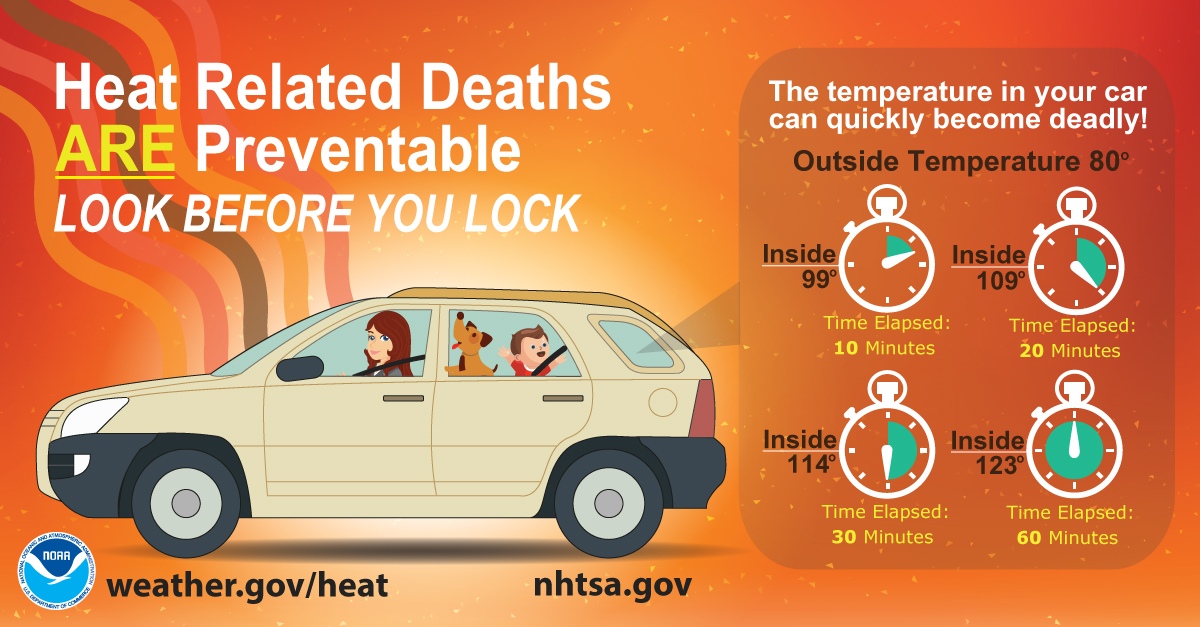
Post 2: Four Questions To Ask Before Working Outdoors
Facebook: Four questions you need to ask yourself before working or playing outdoors: Do you have enough water? Do you have temporary shade available? Do you know the symptoms of heat-related illnesses? Do you know who to call in an emergency? www.osha.gov/heat
X: Four questions you need to ask yourself prior to working or playing outdoors. www.osha.gov/heat #ilwx #mowx #WeatherReady
Alt Text: Four questions you need to ask yourself before working or playing outdoors: Do you have enough water? Do you have temporary shade available? Do you know the symptoms of heat-related illnesses? Do you know who to call in an emergency?
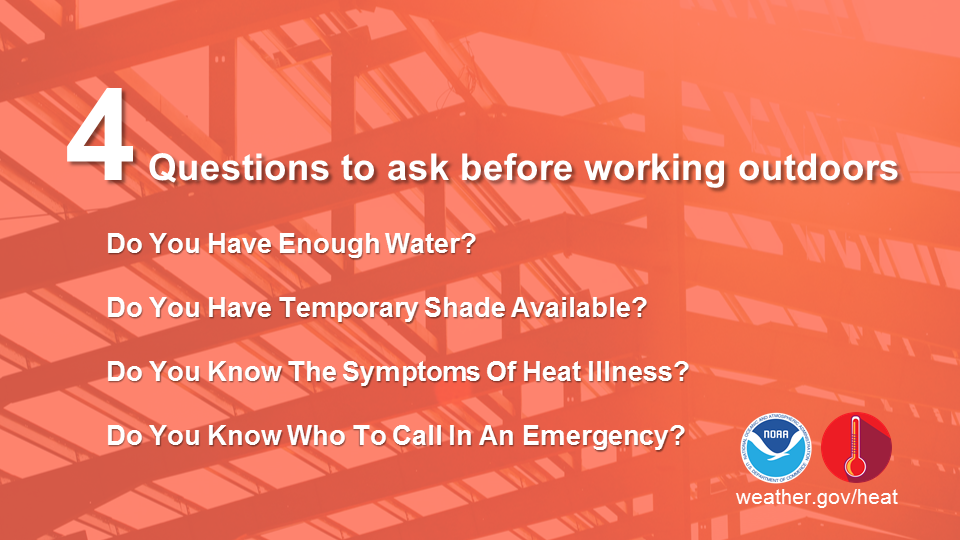
Post 3: Heat Exhaustion v. Heat Stroke
Facebook: During hot and humid weather, your body's ability to cool itself is challenged in ways you may not expect. When your body heats too rapidly, or when too much fluid or salt is lost through dehydration or sweating, you may experience a heat-related illness. Stay Weather-Ready by learning the symptoms of excessive heat exposure and the appropriate responses. weather.gov/safety/heat-illness
X:During hot and humid weather, your body's ability to cool itself is challenged in ways you may not expect. Stay #WeatherReady by learning the symptoms of excessive heat exposure and the appropriate responses. weather.gov/safety/heat-illness
Alt Text: Heat Exhaustion vs Heat Stroke. Symptoms of heat exhaustion include dizziness, thirst, heavy sweating, nausea, and weakness. Act fast by moving to a cooler area, loosening clothing, sipping cool water. Seek medical help if symptoms don't improve. Heat exhaustion can lead to heat stroke. Symptoms of heat stroke include confusion, dizzines, and becoming unconscious. Act fast by calling 911, moving the person to a cooler area, loosening clothing and removing extra layers, and cooling with water or ice. Heat stroke can cause death or permanent disability if emergency treatment is not given.

Post 4: Heat Safety Everywhere
Facebook: Heat is typically the leading cause of weather-related fatalities each year. Heat waves have the potential to cover a large area, exposing a high number of people to a hazardous combination of heat and humidity, which can be very taxing on the body. Learn how to stay safe during a heat wave at weather.gov/heat
X: During a heat wave, practice heat safety wherever you are. Heat related deaths and illnesses are preventable! #WeatherReady #mowx #ilwx www.weather.gov/heat
Alt Text: Practice Heat Safety wherever you are. Job Sites: stay hydrated and take breaks in the shade as often as possible. Indoors: Check up on the elderly, sick and those without AC. Vehicles: Never leave kids or pets unattended - LOOK before you LOCK. Outdoors: Limit strenuous outdoor activities, find shade, and stay hydrated. Heat-related deaths are preventable. Protect yourself and others from the dangerous impacts of heat.

☀️Seguridad Calor
Contenido 1: Seguridad en los Autos
Facebook: ¡Nunca, nunca, nunca deje a niños, discapacitados, personas mayores o mascotas en coches aparcados y sin atender! Estudios demuestran que la temperatura interior de un coche aparcado puede ascender rápidamente a niveles peligrosos para personas y animales. Dejar las ventanas entreabiertas no reduce significativamente el aumento de la temperatura. Los efectos pueden ser más graves en los niños porque aún no tienen la capacidad de regular su temperatura corporal de forma eficiente. weather.gov/safety/heat-children-pets #HeatSafety
X: ¡Nunca, nunca, NUNCA deje a niños, discapacitados, o mascotas en coches aparcados sin atender! weather.gov/safety/heat-children-pets #HeatSafety
Alt Text: Las muertes relacionadas con el calor son evitables. Mire antes de poner seguro. ¡La temperatura en su coche puede llegar a ser rápidamente mortal!
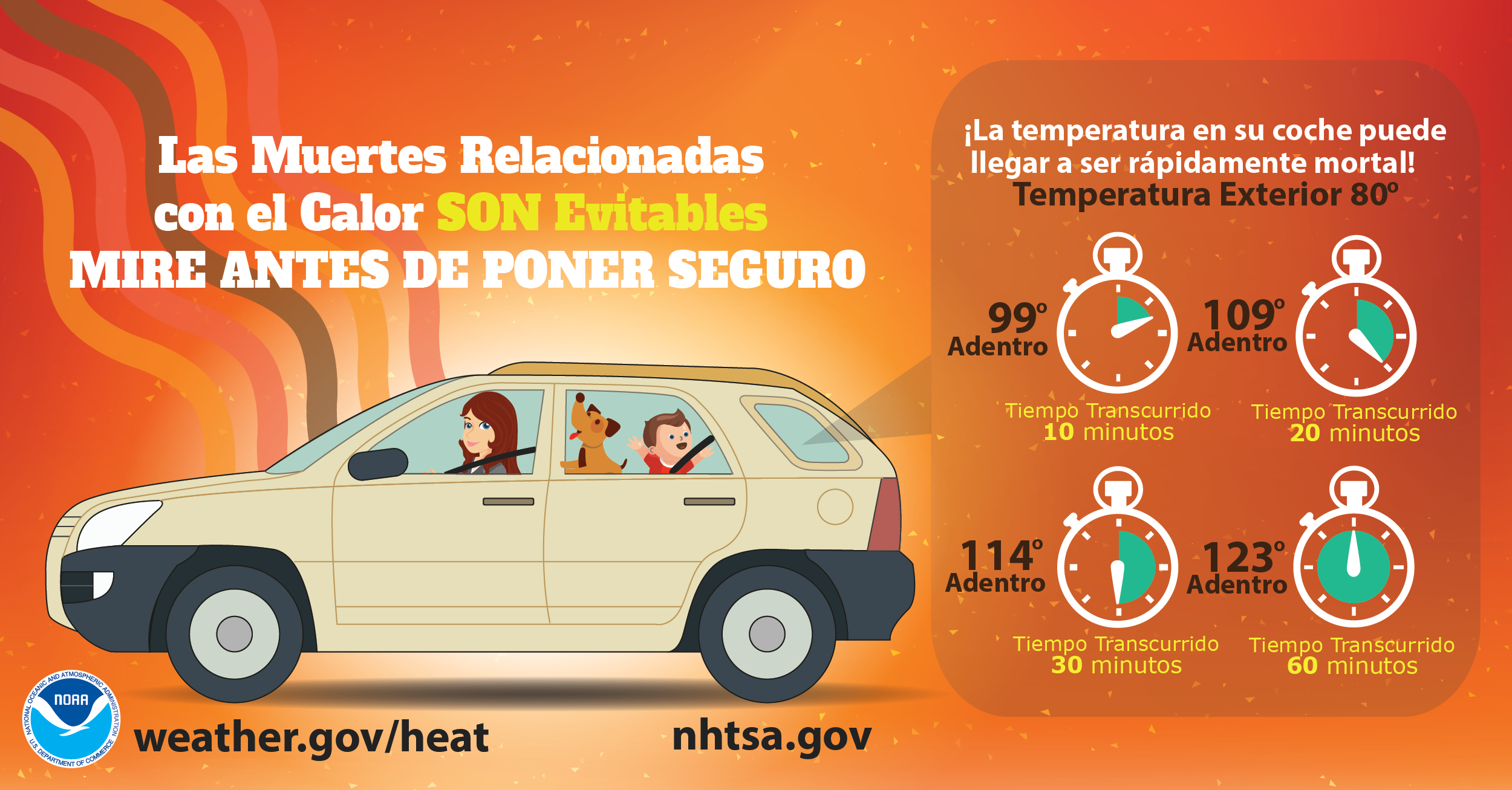
Contenido 2: Cuatro preguntas a hacer antes de trabajar o jugar al aire libre
Facebook: Cuatro preguntas a hacer antes de trabajar o jugar al aire libre: ¿Tiene suficiente agua? ¿Tiene sombra disponible temporeramente? ¿Conoce los síntomas de un golpe de calor? ¿Sabe a quién llamar en caso de una emergencia? osha.gov/heat
X: Cuatro preguntas a hacer antes de trabajar o jugar al aire libre. osha.gov/heat
Alt Text: Cuatro preguntas a hacer antes de trabajar o jugar al aire libre: ¿Tiene suficiente agua? ¿Tiene sombra disponible temporeramente? ¿Conoce los síntomas de un golpe de calor? ¿Sabe a quién llamar en caso de una emergencia?
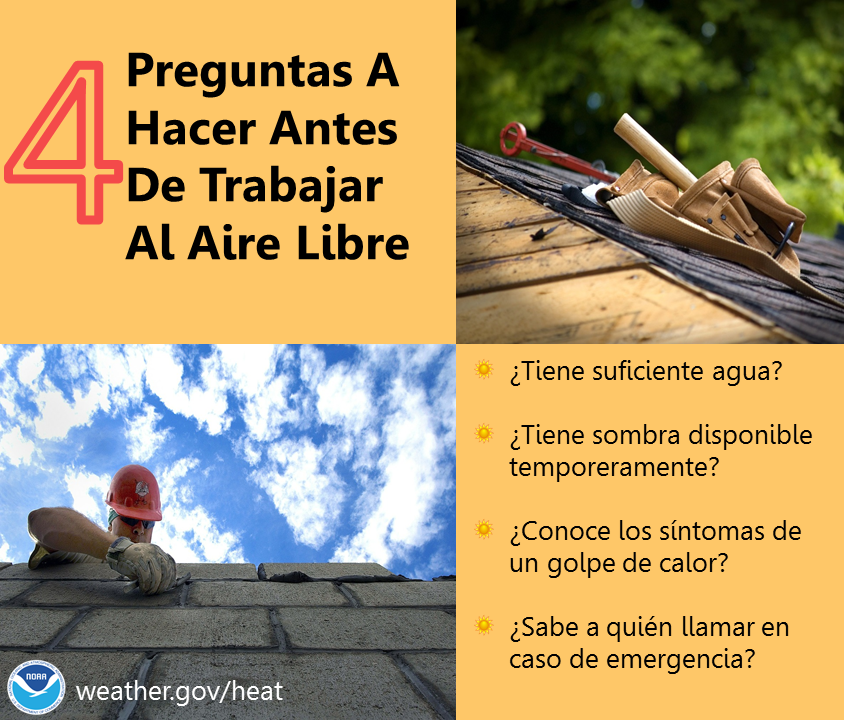
Contenido 3: ¿Agotamiento debido al calor o insolación?
Facebook: Durante tiempo cálido y húmedo, la habilidad de su cuerpo para refrescarse puede ser desafiada en maneras que pueden sorprender. Cuando su cuerpo se calienta muy rápido, o cuando pierde demasiadas sales o fluidos a través de la deshidratación o sudor, puede experimentar enfermedades relacionadas al calor. Para mantenerse listo, aprenda sobre los síntomas de exposición excesiva al calor y las respuestas adecuadas. weather.gov/safety/heat-illness
X: Durante tiempo cálido y húmedo, la habilidad de su cuerpo para refrescarse puede ser desafiada en maneras que pueden sorprender. Para mantenerse listo, aprenda sobre los síntomas de exposición excesiva al calor y las respuestas adecuadas. weather.gov/safety/heat-illness
Alt Text: Agotamiento Debido al Calor: Mareos, Sed, Sudor intenso, Náuseas, Debilidad. Actúe Rápido: Muévase a un lugar fresco, Use ropa ligera, Tome agua fresca, Busque ayuda médica si sus síntomas no mejoran. El agotamiento debido al calor puede causar insolación. Insolación: Confusión, Mareos, Pérdida del conocimiento. Actúe Rápido: Llame al 911, Mueva a la persona a un área fresca, Use ropa ligera y quite capas de más, Enfríe su temperatura corporal con agua o hielo. La insolación podría causar la muerte o incapacidad permanente si no se da tratamiento urgente.
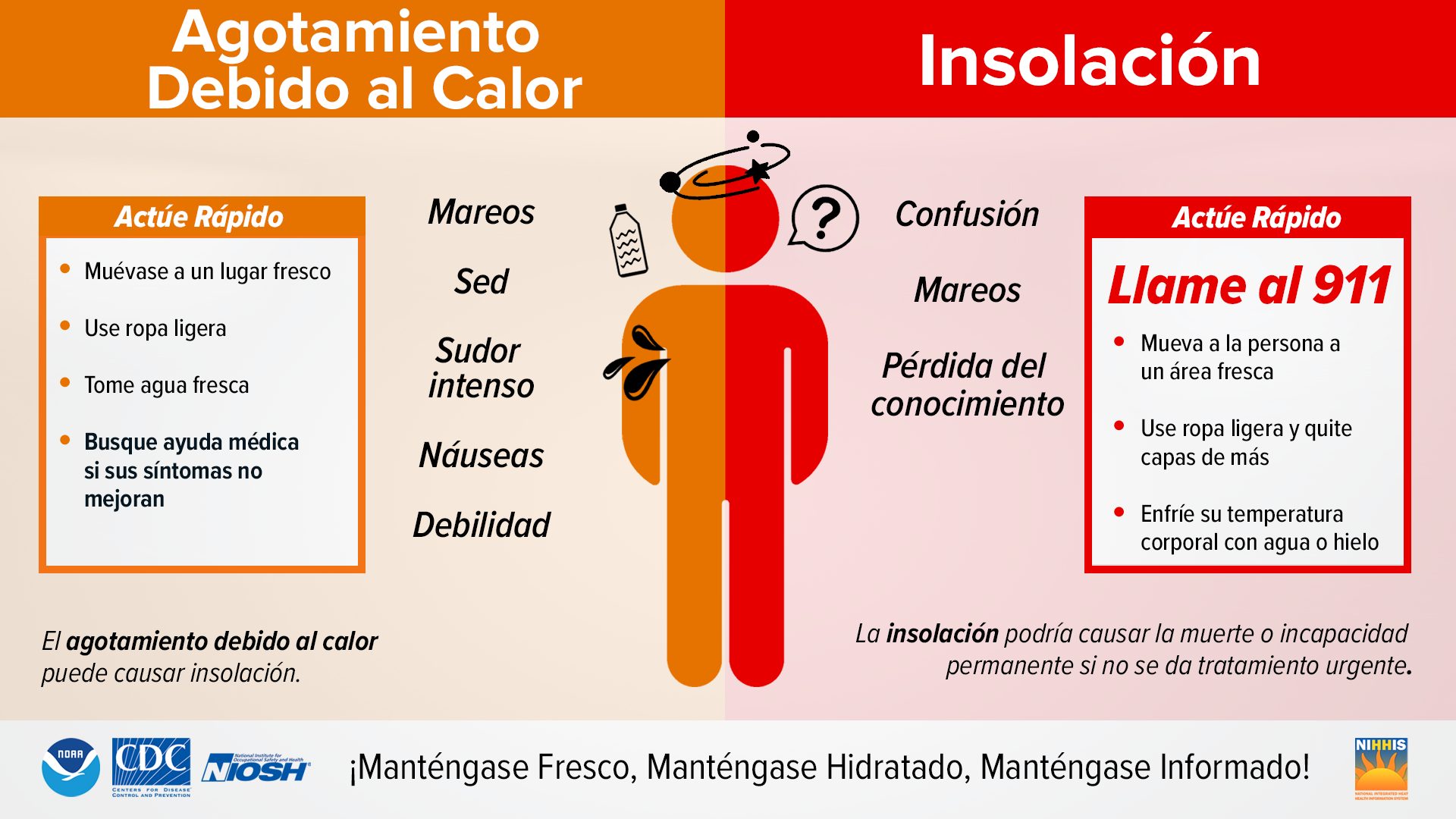
Contenido 4: Seguridad del Calor
Facebook: El calor suele ser la causa principal de muertes relacionadas con las condiciones del tiempo cada año. Las olas de calor tienen el potencial de afectar un área grande, exponiendo a una gran cantidad de personas a una combinación peligrosa de calor y humedad, que puede ser muy agotadora para el cuerpo. Aprenda a mantenerse seguro durante una ola de calor en weather.gov/heat #HeatSafety
X: Durante una ola de calor, practique Seguridad del Calor dondequiera que esté. ¡Las muertes y enfermedades relacionadas con el calor son prevenibles! #WeatherReady weather.gov/heat
Alt Text: Practique seguridad del calor a donde quiera que vaya. Las muertes relacionadas con el calor son evitables. Protéjase usted y a los demás de las olas de calor. Lugares de trabajo - manténgase hidratado y tome descansos bajo la sombra tan a menudo como sea posible. En el interior - revise a los ancianos, enfermos y aquellos sin acondicionador de aire. Vehículos - nunca deje a los niños ni mascotas desatendidas. Mire antes de poner seguro. Al aire libre - limite actividades extenuantes al aire libre, busque sombra, y manténgase hidratado.
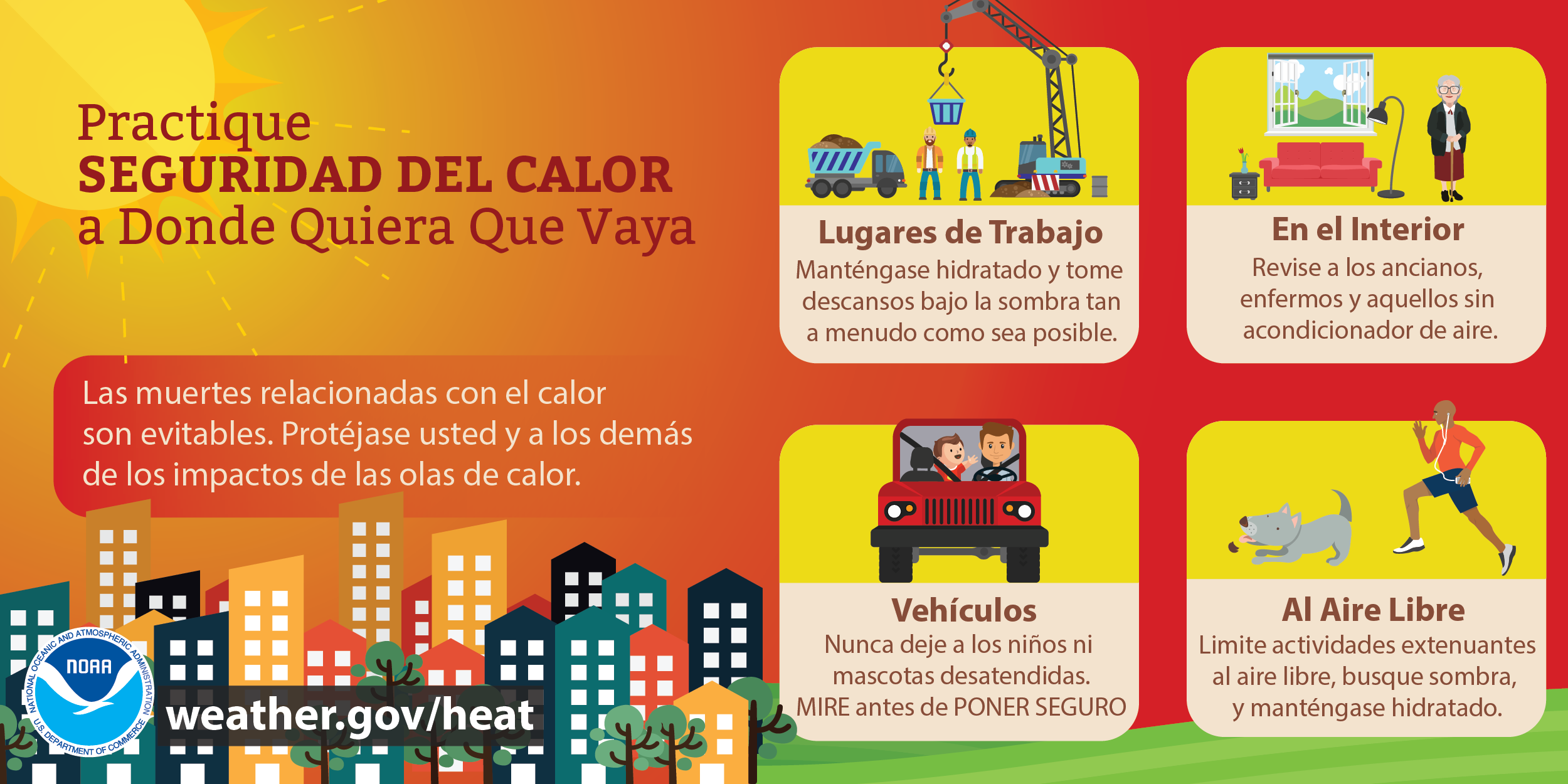
☀️Heat Safety (ASL)
Our summer safety tips are available in American Sign Language. Please watch the video below for more information.
Post 1: Placeholder
Facebook: Placeholder
X: Placeholder
Alt Text: Placeholder

❄️Winter Preparedness
Post 1: Winter Storm Watch vs Warning
Facebook: Do you know the difference between a Winter Storm Watch, Winter Weather Advisory, and Winter Storm Warning? A Winter Storm Watch means it's time to get prepared and put your safety kit in the car. An Winter Weather Advisory means you should be aware that travel difficulties are expected and be cautious. A Winter Storm Warning means dangerous winter weather and considerable travel problems are expected, it's time to take action and change travel plans!
X: A Winter Storm WATCH means get prepared for winter weather. A Winter Storm WARNING means take action to be safe! #WeatherReady https://www.weather.gov/safety/winter-ww
Alt Text: A winter storm watch means dangerous winter weather including heavy snow, sleet, or freezing rain is possible in the future. Travel problems are possible. Get Prepared. A winter weather advisory means potentially dangerous winter weather is expected within the next 12 to 36 hours or is occurring. Travel difficulties are expected. Be Aware. A winter storm warning means dangerous winter weather is expected within the next 12 to 36 hours or is occurring. Considerable travel problems are expected. Take Action.
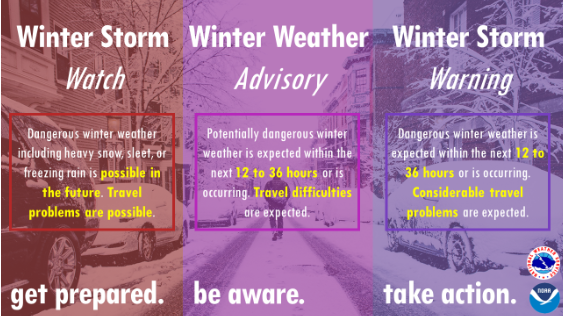
Post 2: Winter Storm Planning Timeline
Facebook: Are you prepared for a winter storm? If the forecast calls for winter weather, begin preparing NOW. Don’t wait until the last minute. Learn more at https://www.weather.gov/safety/winter-safety
X: Are you prepared for a winter storm? If the forecast calls for winter weather, begin preparing NOW. Don’t wait until the last minute. #WeatherReady https://www.weather.gov/safety/winter-before
Alt Text: A few days out: if the forecast calls for winter weather, start preparing now. Have emergency supplies for your home & car. Check your smoke and carbon monoxide detectors. Replenish fuel for your car and heating sources. The day before: forecast accuracy continues to improve, so keep checking the latest. Adjust plans. Have multiple ways to receive Warnings. Bring pets indoors and ensure they have water. During and after: remain vigilant and stay informed. Drive only if necessary. Check on neighbors and family. Properly ventilate emergency heat sources. Keep generators at least 20 feet from your home. Take it easy when shoveling.
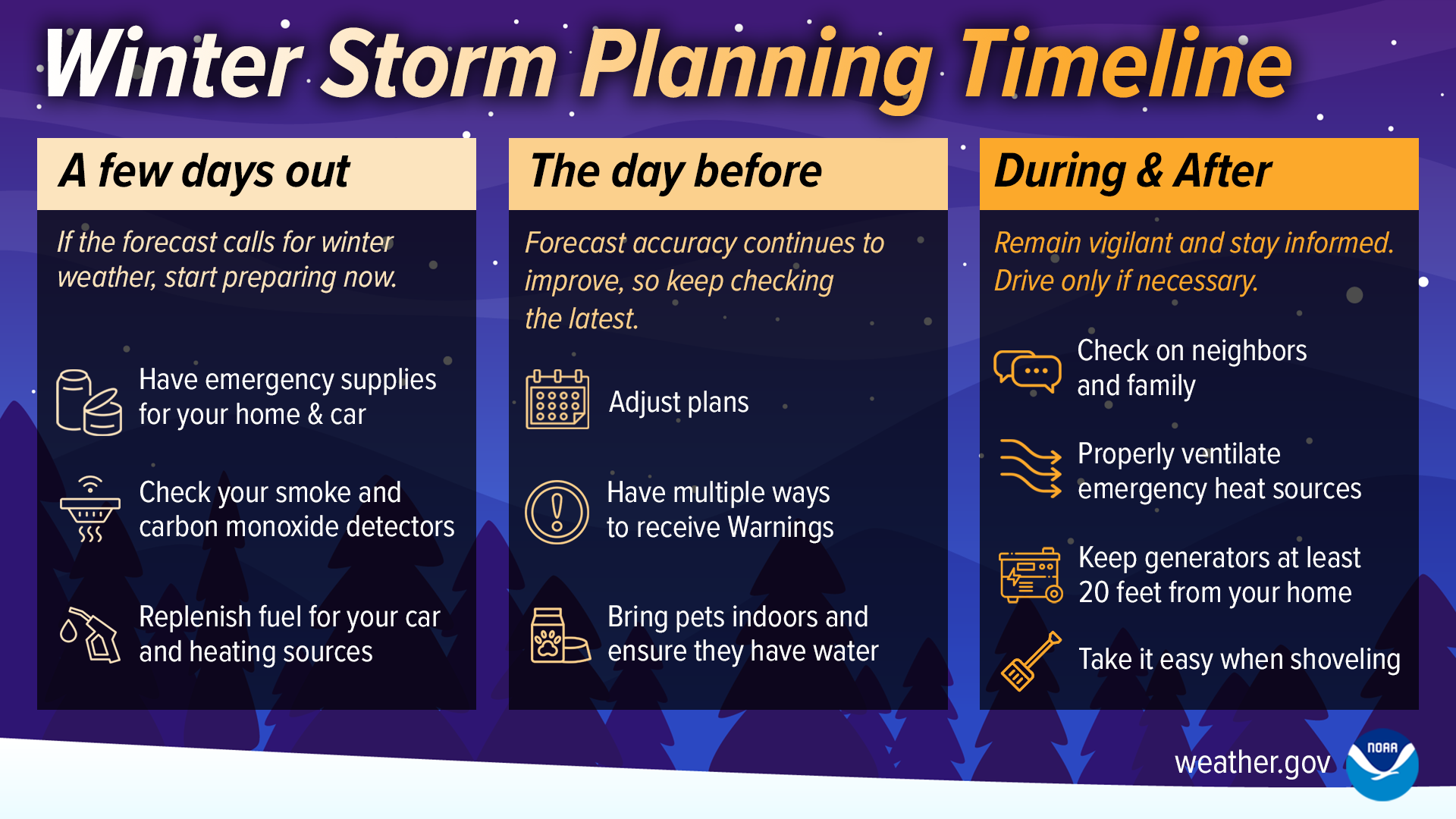
Post 3: First Snow
Facebook: While lots of snow in the middle of winter can certainly cause dangerous travel conditions, many times it’s the first snow of the season that can cause accidents. Be extra careful as you and other drivers adjust to driving in poor conditions. Slow down, don’t use cruise control, and keep your distance from other vehicles. Don’t let the first snow sneak up on you!
X: While lots of snow in the middle of winter can cause dangerous travel conditions, the first snow of the season can also cause accidents. Be careful as you and other drivers adjust to driving in poor conditions. Don’t let the first snow sneak up on you! #WeatherReady #mowx #ilwx
Alt Text: The first snow of the year can be a sneaky winter hazard, winter hazards that cause big impacts and make travel difficult without making big news. The first snow of the year can often cause major problems on the road as people adjust to the poor driving conditions. Safety tips: slow down, don't use cruise control, leave plenty of distance between you and other vehicles.
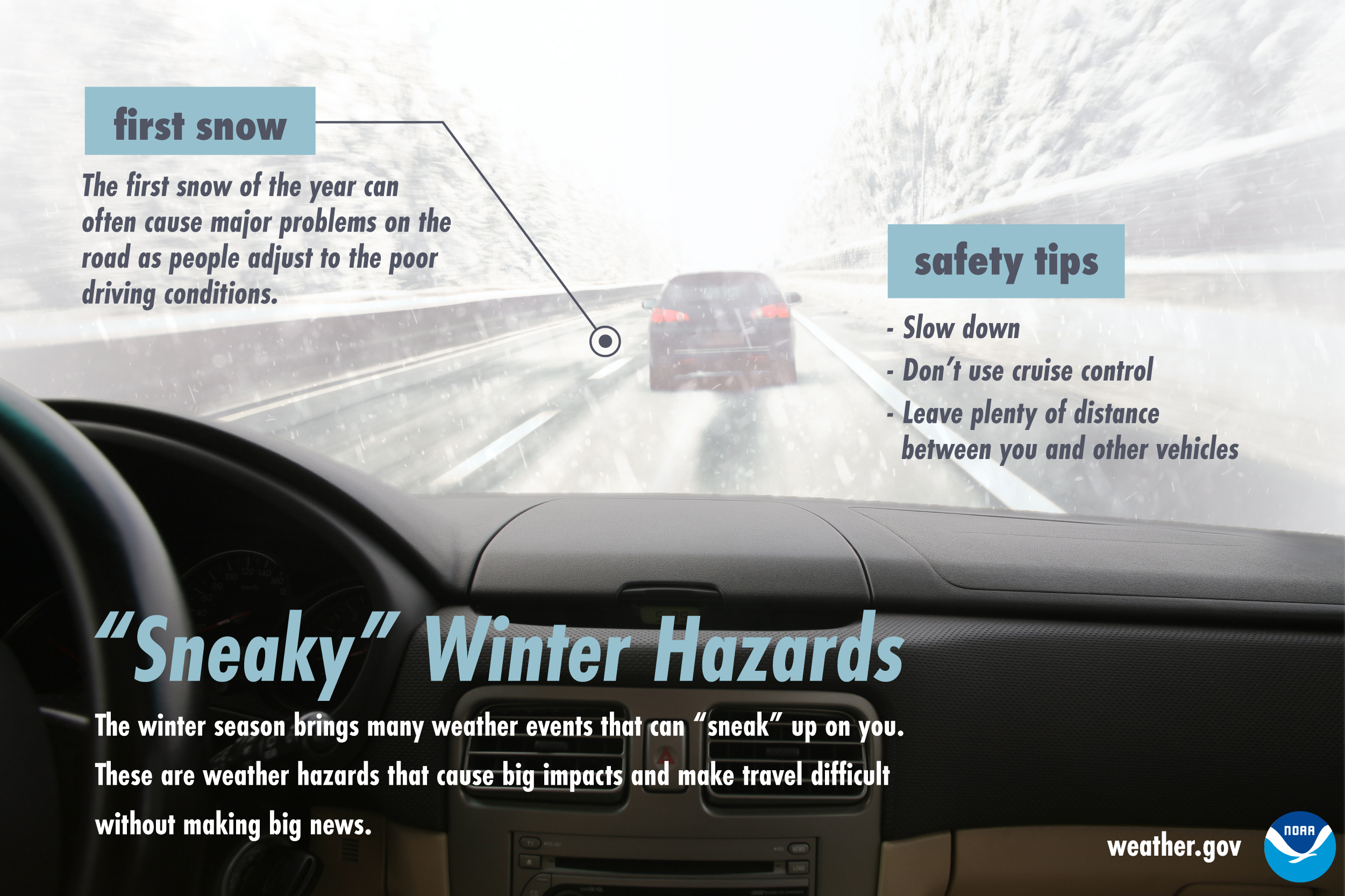
Post 4: Shovel Smart
Facebook: Slippery sidewalks and roads aren’t the only things to look out for in late winter and early spring snow storms--shoveling snow can be a health risk as well. Remember to stay hydrated, take frequent breaks, and move only small amounts with each shovel pass. Learn more at weather.gov/winter
X: Shoveling snow can be a health risk, so remember to take it easy. Learn more at weather.gov/winter #WeatherReady
Alt Text: Shovel Smart! Shoveling heavy, wet snow can cause back injuries and heart attacks. Don't push yourself. Dress warmly, making sure to cover your heat, fingers, and toes. Stay hydrated, but avoid heavy meals right before or after shoveling. Move only small amounts of snow with each pass of the shovel. Take frequent breaks, and stop shoveling entirely if you feel exhausted.
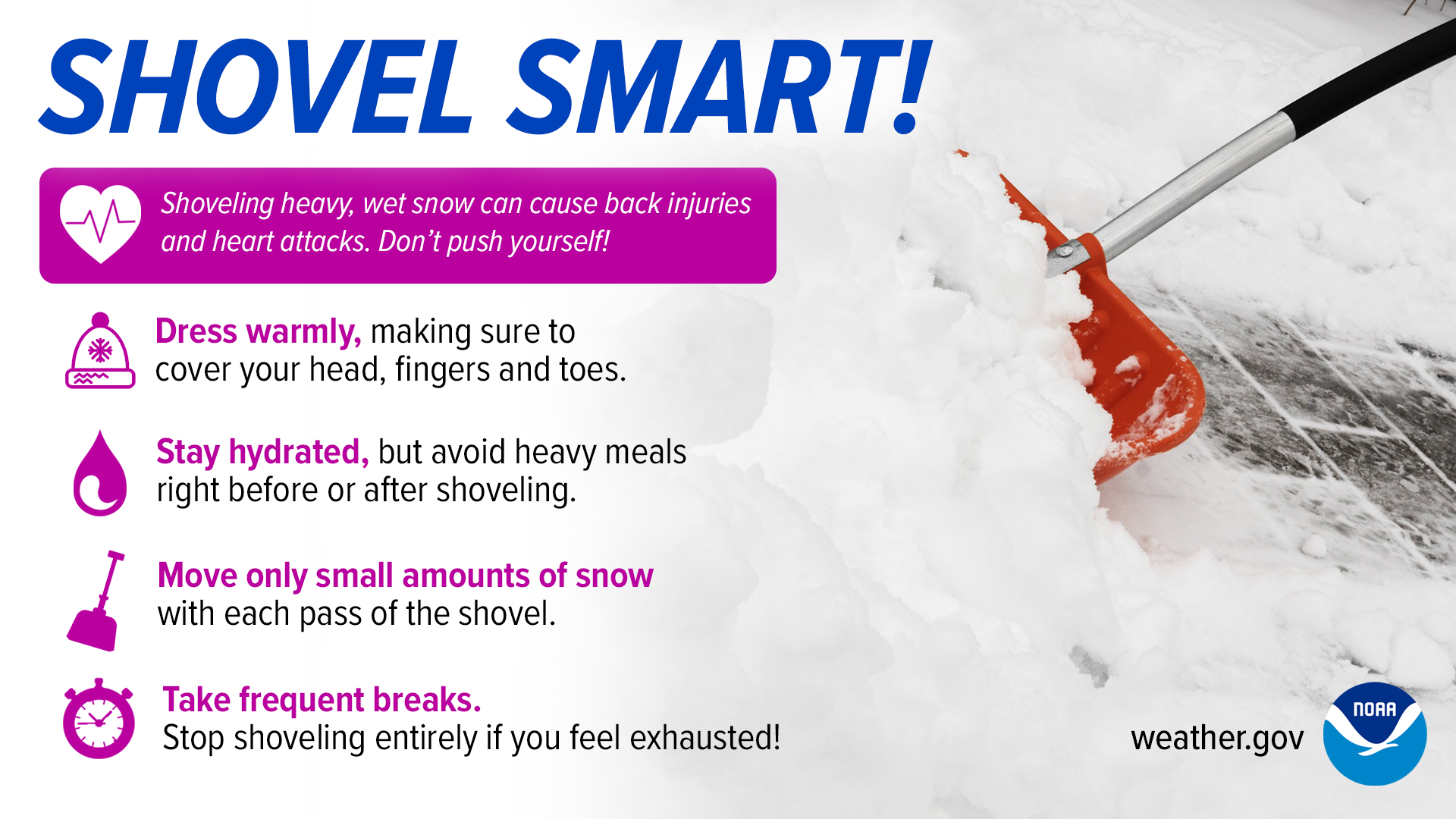
Post 5: Driving in Snow for Trucks and SUVs
Facebook: Driving in snow and other wintry precipitation can be dangerous, and even trucks and SUVs with four-wheel drive can still lose traction in the snow. Stay Weather-Ready by always using extra caution when driving in wintry conditions — no matter what you’re driving. Do yourself and those around you a favor: take it slow and leave room between you and the next vehicle so you have time to react to changing road conditions.
X: Even trucks and SUVs with four-wheel drive can still lose traction in the snow. Stay #WeatherReady by always using extra caution when driving in wintry conditions — no matter what you’re driving. #mowx #ilwx
Alt Text: A truck tire with snow between the treads. Text: Trucks & SUVs can lose traction in ice and snow. Even four-wheel drive vehicles can lose traction in bad weather. All vehicles are susceptible to ice and snow. Know your limits.
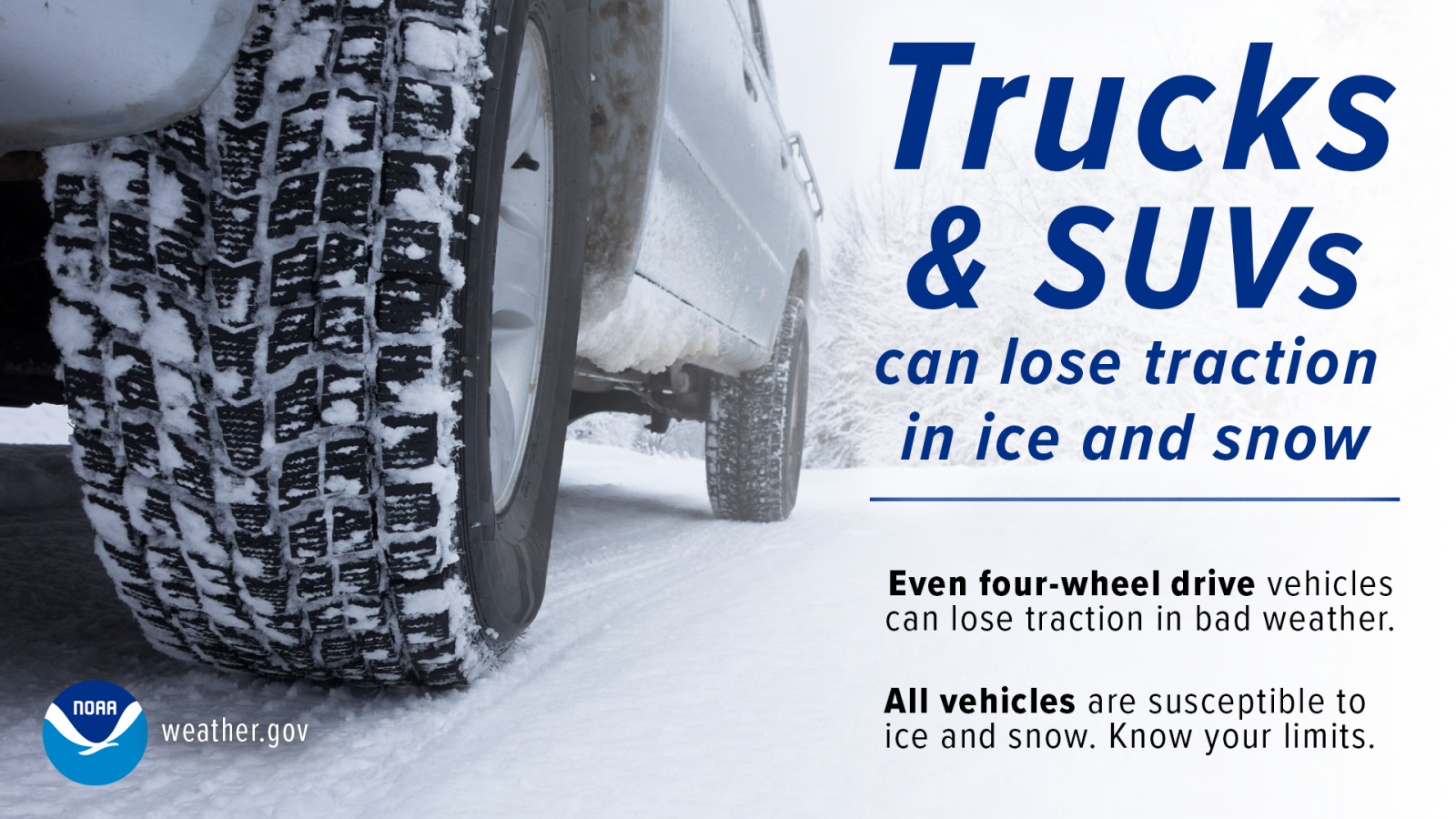
Post 6: Don't Underestimate Sleet
Facebook: Sleet can be deceptively dangerous - it’s much more dense than snow, so take it easy when shoveling. Use extreme caution when driving during or after sleet. Reduce speed, allow plenty of stopping distance, and do not use cruise control. Learn more at https://www.weather.gov/safety/winter
X: Sleet can be deceptively dangerous - it's much more dense than snow, so take it easy when shoveling. Use extreme caution when driving during or after sleet. Reduce speed, allow plenty of stopping distance, and do not use cruise control. #WeatherReady https://www.weather.gov/safety/winter
Alt Text: Don’t underestimate sleet dangers! Take it easy when shoveling. Sleet can be much more dense than snow. Go slowly and don’t overexert yourself. Use extreme caution when driving. Sleet can cause dangerous road conditions and reduced visibility. Reduce speed, allow plenty of stopping distance, and do not use cruise control.
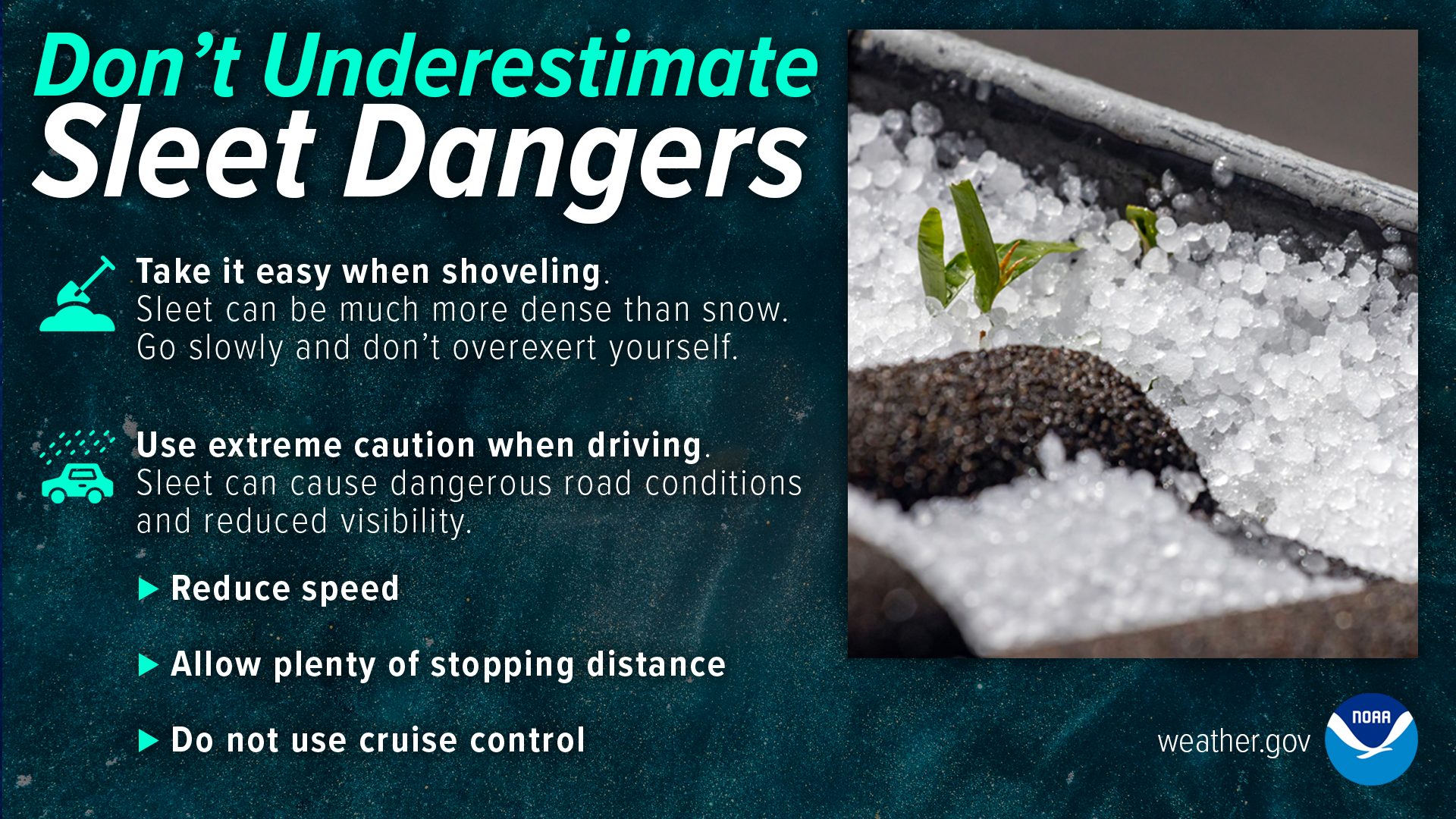
Post 7: Freezing Rain Safety
Facebook: When super cold rain falls onto below freezing surfaces, freezing rain occurs and ice will form on pavement, sidewalks, and handrails. Freezing rain is more dangerous than snow because ice can form on the pavement while also being difficult to see. Don't drive if at all possible when freezing rain is, or recently was, occurring.
X: Freezing rain is more dangerous than snow because ice can form on the pavement while also being difficult to see. Don't drive if at all possible when freezing rain is, or recently was, occurring. #WeatherReady #WinterSafety
Alt Text: A wet paved road through a snowy woods with a neon green street sign in the foreground that says "Freezing rain is the worst". Freezing rain is more dangerous than snow, as ice can form on pavement. Watch out for falling branches and powerlines. Don't drive if there is, or recently was, freezing rain.
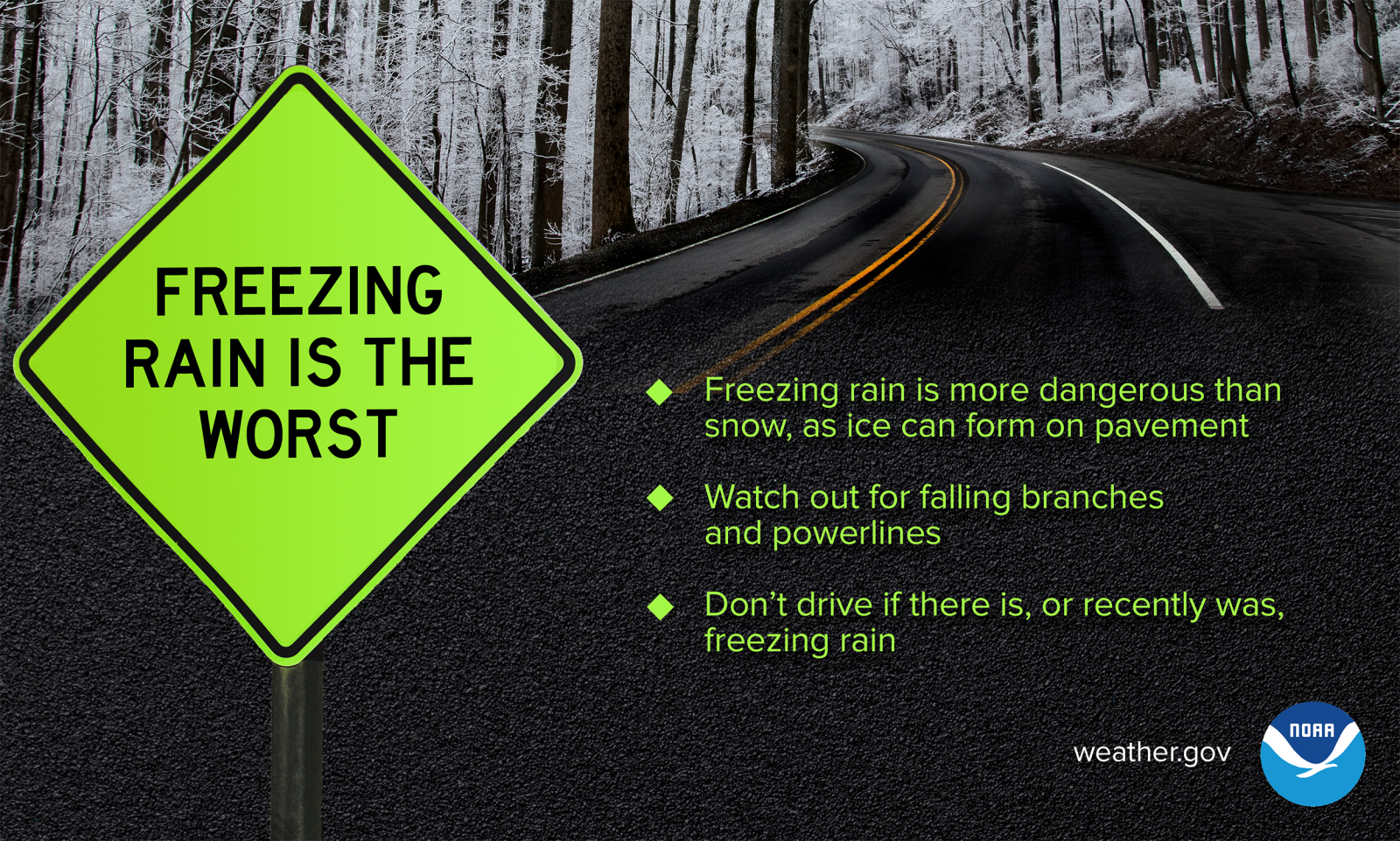
Post 8: Black Ice
Facebook: When recent rain or snowmelt comes into contact with freezing temperatures, black ice can form — and you might not even see it. While black ice is more prevalent at night, it can often stick around for the morning commute. Use caution when driving...don’t let black ice sneak up on you.
X: Don’t let black ice sneak up on you! When recent rain or snowmelt comes into contact with freezing temperatures, black ice can form — and you might not even see it. #WeatherReady #mowx #ilwx
Alt Text: Don't Let Black Ice Sneak up On You. It can form on any road, but also along curbs and drainage areas due to melting snow. More prevalent at night, but can still be around in the morning. Use caution driving during freezing temperatures after rain or snowmelt.
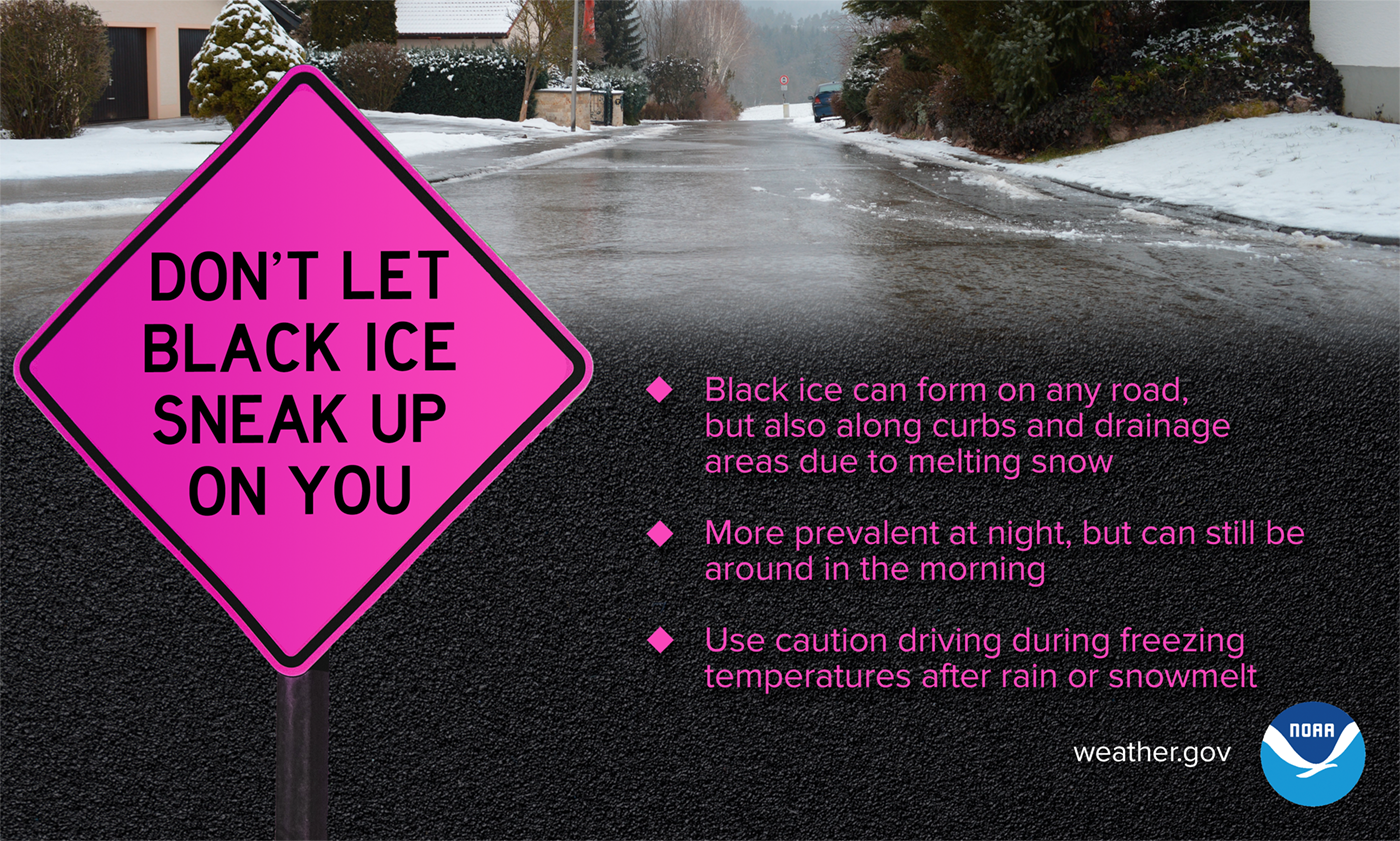
Post 9: Don't Slip! Ice Safety
Facebook: Slipping on an icy sidewalk can lead to serious injuries or even death, especially for the elderly. Help prevent the formation of ice by salting walkways and turning off sprinklers in advance of cold weather. Learn more ice safety at https://www.weather.gov/safety/winter-ice-frost
X: Slipping on an icy sidewalk can lead to serious injuries or even death, especially for the elderly. Help prevent the formation of ice by salting walkways and turning off sprinklers in advance of cold weather. Learn more at https://www.weather.gov/safety/winter-ice-frost #WeatherReady #mowx #ilwx
Alt Text: Don’t slip! Icy surfaces can lead to serious injuries! Help prevent ice by salting walkways and turning off sprinklers in advance of the cold. Walk on treated or non-icy surfaces with better traction, if possible. Wear proper winter footwear with rubber treads. Take slow, short steps so that you’ll be able to react to icy conditions.

Post 10: Safety on Pond and Lake Ice
Facebook: After a big freeze it can be fun to walk or skate around on ice. But ice is never completely safe. Know how thick the ice is, and what the limits of your activity are ahead of time. Stay away from any cracks or melting ice. If you don’t know, don’t go! weather.gov/safety/winter
X: After a big freeze it can be fun to walk or skate around on ice. But ice is never completely safe. Know how thick the ice is, and what the limits of your activity are ahead of time. Stay away from any cracks or melting ice. If you don’t know, don’t go! #WeatherReady #mowx #ilwx
Alt Text: Safety On Ice: Ice is never 100% safe. If you don't know, don't go! Minimum ice thickness guidelines for new, clear ice only: Less than 2 inches: stay off! 4 inches: supports ice fishing and walking. 5 inches: supports small groups ice skating. 6 inches: supports snowmobile ATV. 9 inches: supports cars. 12 inches: supports medium size trucks. Stay away from any cracks and melting ice.
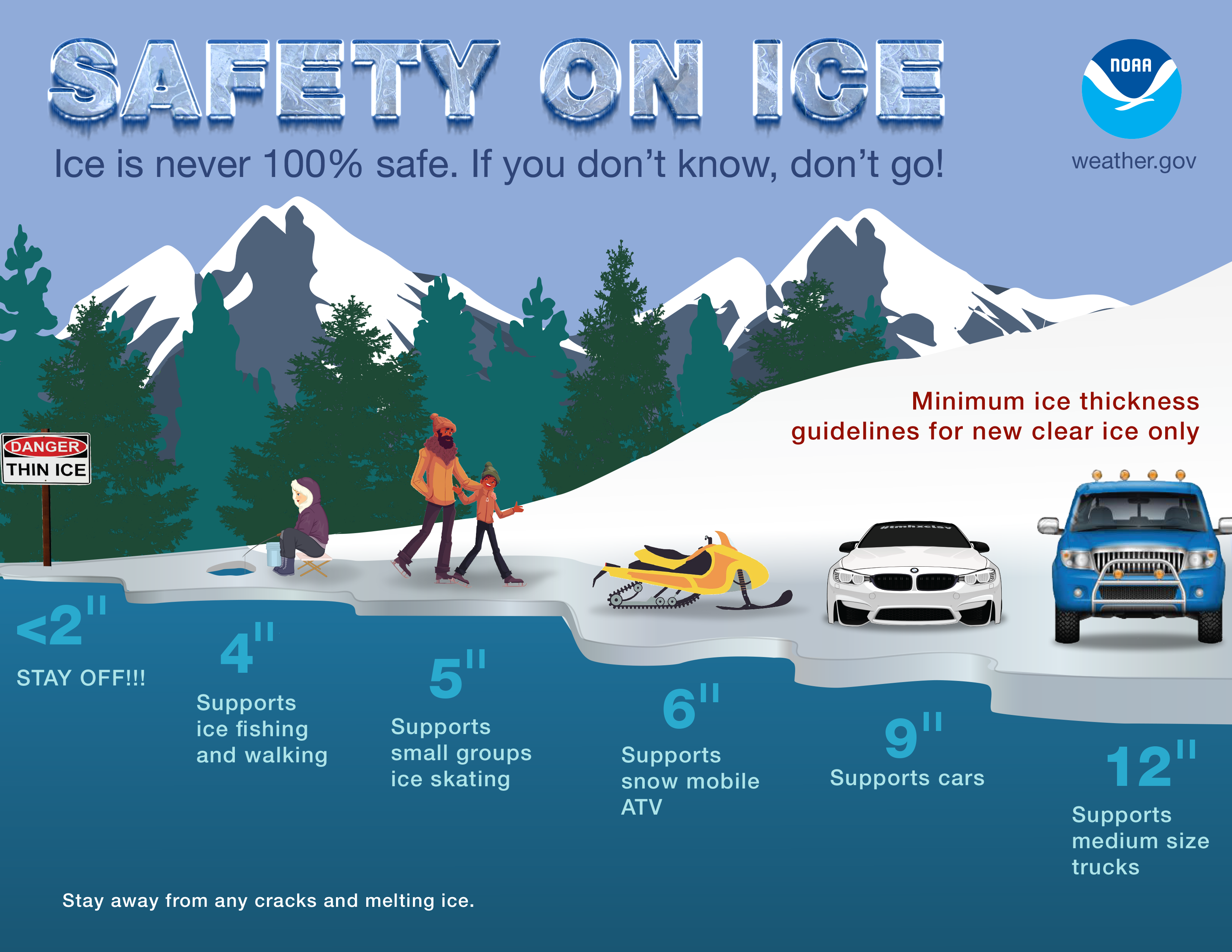
Post 11: Wind Chill Science
Facebook: Extremely cold air affects millions of people across the United States every winter and even into parts of the spring. This Arctic air, together with brisk winds, can lead to dangerously cold wind chill values, which can cause your body to lose heat quickly. Find a heating shelter near you by texting SHELTER and your zip code to 43362 (ex: Shelter 63139)
X: Arctic air, together with brisk winds, can lead to dangerously cold wind chill values. weather.gov/safety/cold-wind-chill-chart #WeatherReady #mowx #ilwx
Alt Text: The Science of Wind Chill. Under calm conditions, the body radiates heat, creating a layer of warmth between our skin and the cold surrounding. A woman wearing boots, pants, a coat, hat and earmuffs sands in a winter scene and appears happy. Her body temperature is 98.6 degrees F (average temperature of the human body). But when it's windy, the moving air breaks up this insulating layer. It speeds up heat loss by whisking away the warmth from our skin. The woman from before now looks uncomfortable as wind moves the heat away from her body. Hypothermia begins when our body temperature drops two to four degrees.

Post 12: Staying Warm When It's Cold
Facebook: When extreme cold grips the area it can be difficult to stay warm, even inside. Keep these safety tips in mind: don't use your oven to heat your home, close off rooms to avoid wasting heat, and wear extra layers of clothing. weather.gov/safety/winter
X: When extreme cold grips the area it can be difficult to stay warm, even inside. Keep these safety tips in mind: don't use your oven to heat your home, close off rooms to avoid wasting heat, and wear extra layers of clothing. weather.gov/safety/winter #WeatherReady #mowx #ilwx
Alt Text: Staying warm when the power is out: close blinds or curtains to keep in some heat. Close off rooms to avoid wasting heat. Wear layers of loose-fitting, lightweight, warm clothing. Eat and drink: food provides energy to warm the body. Avoid caffeine and alcohol. Stuff towels or rags in cracks under doors. Visit weather.gov/winter for more information.
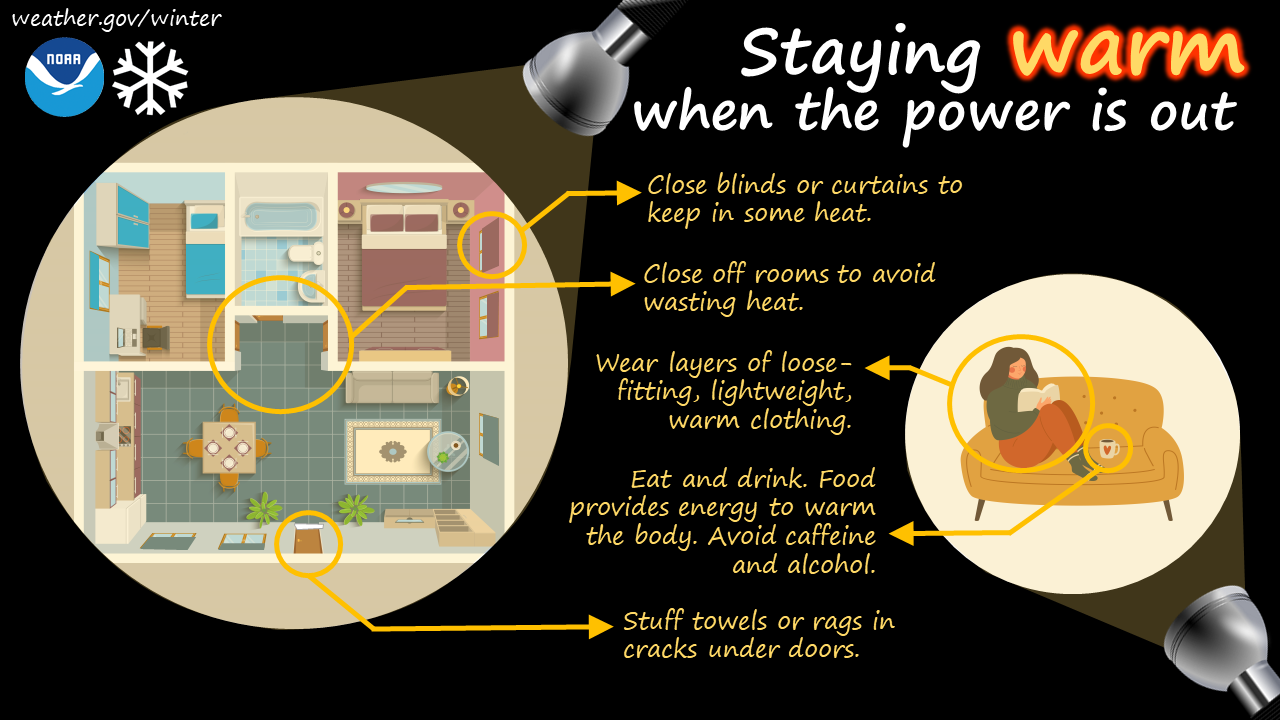
Post 13: Winter Safety for Workers
Facebook: Those working outside during the winter need to take extra precaution to keep themselves safe in cold temperatures and changing precipitation. Be aware of the signs of hypothermia and dress in layers to be able to keep your body at a safe temperature based on your activity level. Find out more at osha.gov/dts/weather/winter_weather/
X: Those working outside during the winter need to take extra precaution to keep themselves safe in cold temperatures and changing precipitation. Find out more at osha.gov/dts/weather/winter_weather/ #WeatherReady #mowx #ilwx
Alt Text: Winter Safety For Workers: 1) Wear proper footwear for traction. 2) Drink a warm beverage, stay hydrated. 3) Dress in layers. 4) Take frequent short breaks. 5) Watch for signs of hypothermia. 6) Have a winter emergency supply kit in your vehicle.

❄️Seguridad en Invierno
Contenido 1: Terminología del Clima Invernal
Facebook: ¿Conoce la diferencia entre una Vigilancia de Tormenta Invernal, una Advertencia de Condiciones Invernales y un Aviso de Tormenta Invernal? Una Vigilancia de Tormenta Invernal indica que es momento de estar preparado y que debe colocar un kit de seguridad en su vehículo. Una Advertencia de Condiciones Invernales significa que debe estar al pendiente ya que se esperan dificultades para viajar y debe tomar precaución. Un Aviso de Tormenta Invernal indica que se esperan condiciones invernales peligrosas y problemas considerables para viajar, ¡es momento de tomar acción y cambiar sus planes de viaje! https://www.weather.gov/wrn/winter-storms-espanol-sm
X: Una VIGILANCIA de Tormenta Invernal indica que debe estar preparado para condiciones invernales. ¡Un AVISO de Tormenta Invernal significa que debe tomar acción para mantenerse seguro! https://www.weather.gov/wrn/winter-storms-espanol-sm #ListoMeteorologicamente #WeatherReady
Alt Text: Una Vigilancia de Tormenta Invernal indica que es posible que se presenten en el futuro condiciones invernales peligrosas, incluyendo nevadas fuertes, cellisca o lluvia helada. Serán posibles problemas para viajar. Prepárese. Una Advertencia de Condiciones Invernales significa que se esperan condiciones invernales potencialmente peligrosas dentro de las próximas 12 a 36 horas o ya están ocurriendo. También se esperan dificultades para viajar. Esté al pendiente. Un Aviso de Tormenta Invernal indica que se esperan condiciones invernales peligrosas dentro de las próximas 12 a 36 horas o ya están ocurriendo. También se esperan problemas considerables para viajar. Tome acción.
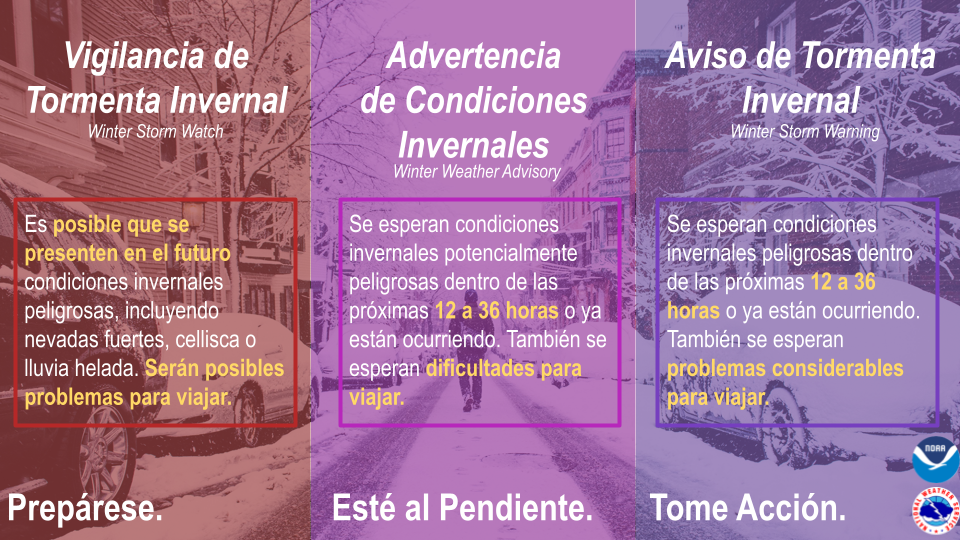
Contenido 2: Cronología de Planificación Ante Tormentas Invernales
Facebook: ¿Está preparado para una tormenta invernal? Si el pronóstico prevé condiciones del tiempo invernales, comience a prepararse AHORA. No espere hasta el último minuto. weather.gov/wrn/winter-storms-espanol-sm
X: ¿Está preparado para una tormenta invernal? Si el pronóstico prevé condiciones del tiempo invernales, comience a prepararse AHORA. No espere hasta el último minuto. #ListoMeteorológicamente weather.gov/wrn/winter-storms-espanol-sm
Alt Text: Cronología de Planificación Ante Tormentas Invernales. Unos días antes: Si el pronóstico indica tiempo invernal, comience a prepararse ahora. Tenga suministros de emergencias para su casa y carro. Verifique los detectores de humo y de monóxido de carbono. Llene de combustible su auto y fuentes de calefacción. El día antes: La precisión del pronóstico continúa mejorando,así que manténganse monitoreando las actualizaciones. Ajuste sus planes. Tenga múltiples maneras de recibir los Avisos. Traiga las mascotas al interior y asegúrese de que tengan agua. Durante y después: Permanezca vigilante y manténgase informado. Maneje solo de ser necesario. Verifique a su familia y vecinos. Ventile adecuadamente las fuentes de calefacción de emergencia. Mantenga los generadores al menos a 20 pies de distancia de su casa. Tómelo con calma cuando palee.
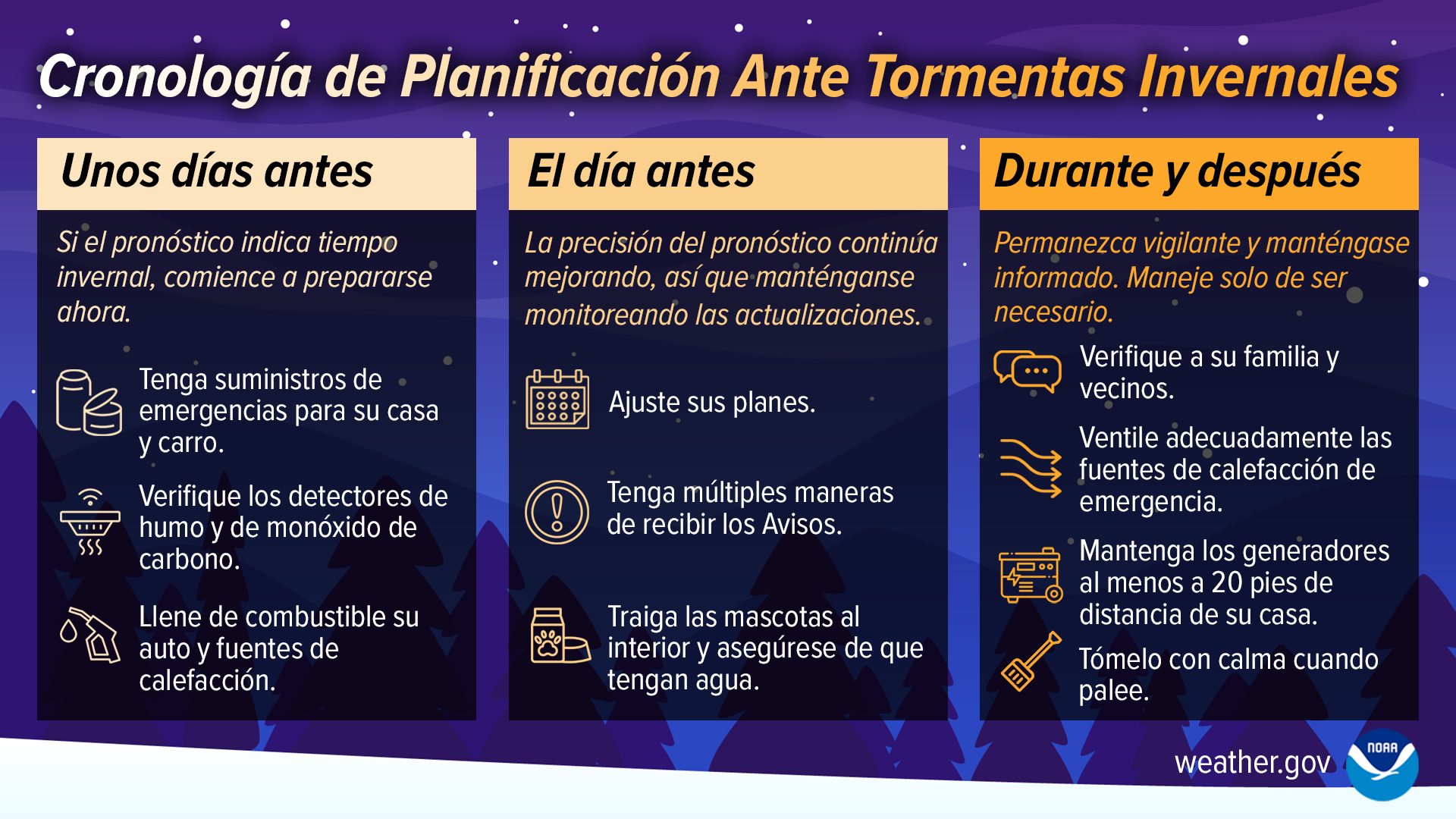
Contenido 3: Prepare su Hogar para Condiciones Invernales
Facebook: ¡Prepare su hogar para emergencias asociadas a las condiciones invernales! Las tormentas invernales pueden crear cortes en el servicio eléctrico e impedirle viajar por días. Mantenga suficiente comida no perecedera, agua y medicamentos para al menos 3 días. Asegúrese de tener ropa cálida, cobijas y un kit de primeros auxilios actualizado. Recargue su celular con anticipación y verifique que cuenta con las Alertas Inalámbricas de Emergencia (WEA, por sus siglas en inglés). weather.gov/wrn/winter-storms-espanol-sm
X: ¡Prepare su hogar para emergencias asociadas a las condiciones invernales! Las tormentas invernales pueden crear cortes en el servicio eléctrico e impedirle viajar por días. Mantenga suficiente comida no perecedera, agua y medicamentos para al menos 3 días. weather.gov/wrn/winter-storms-espanol-sm
Alt Text: ¡Prepare su hogar para emergencias asociadas a las condiciones invernales! Las tormentas invernales pueden crear cortes en el servicio eléctrico e impedirle viajar por días. Mantenga suficiente comida no perecedera, agua y medicamentos para al menos 3 días. Asegúrese de tener ropa cálida, cobijas y un kit de primeros auxilios actualizado. Recargue su celular con anticipación y verifique que cuenta con las Alertas Inalámbricas de Emergencia (WEA, por sus siglas en inglés). weather.gov
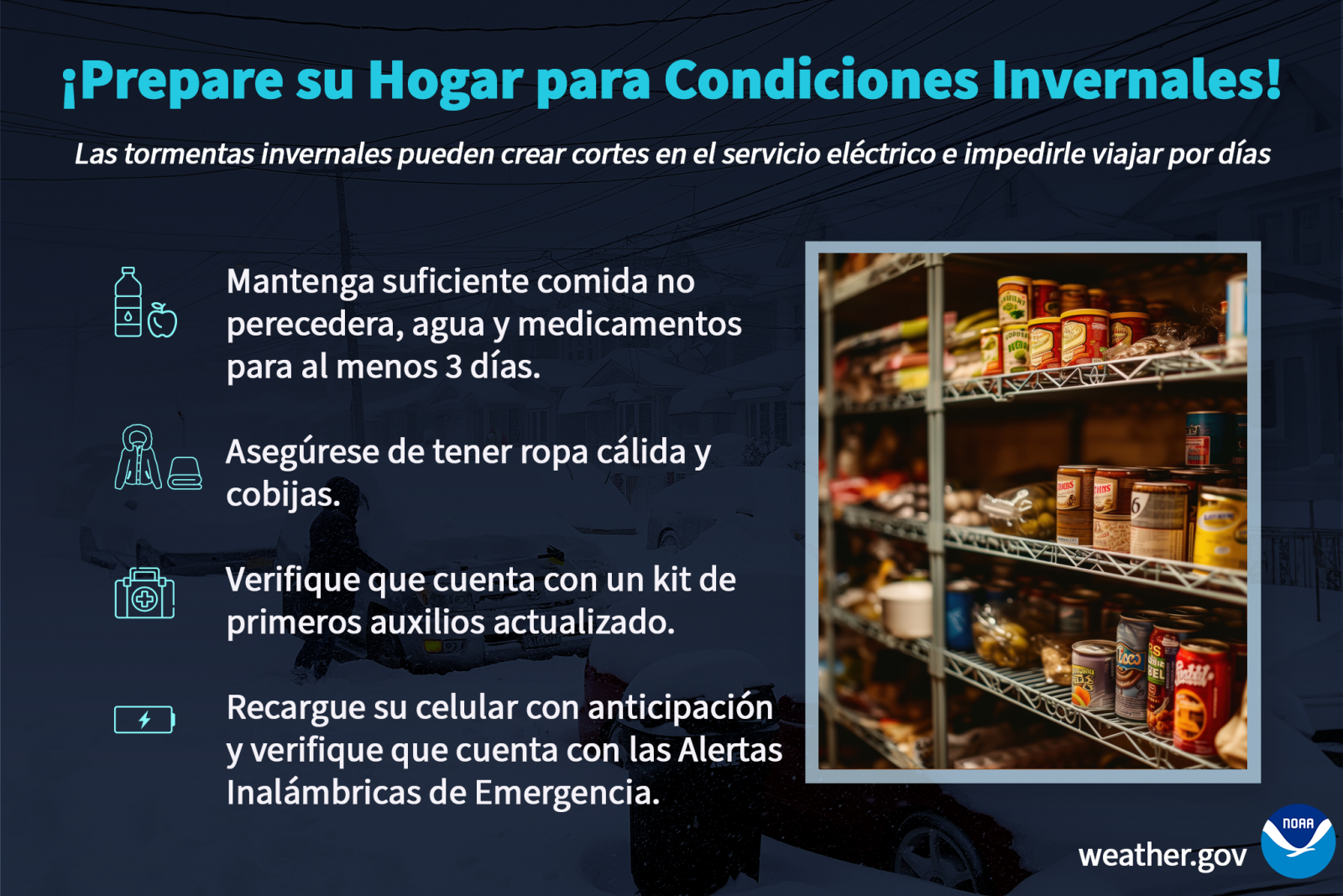
Contenido 4: Palear de Forma Inteligente
Facebook: Las aceras y carreteras resbaladizas no son lo único a tener en cuenta durante las tormentas de nieve - palear la nieve también puede ser arriesgado para la salud. Recuerde mantenerse hidratado, tomar descansos frecuentes, y solamente mover cantidades pequeñas en cada pase. Aprenda más en weather.gov/wrn/winter-storms-espanol-sm
X: Palear la nieve puede ser arriesgado para la salud, así que recuerde tomarlo con calma. Aprenda más en weather.gov/wrn/winter-storms-espanol-sm #ListoMeteorológicamente
Alt Text: ¡PALEE INTELIGENTEMENTE! Palear la nieve húmeda y pesada puede causar lesiones de espalda y ataques al corazón. ¡No se esfuerce demasiado! Vista ropa caliente, asegurándose de cubrir su cabeza, dedos y pies. Manténgase hidratado, pero evite comidas pesadas justo antes o después de palear. Solo mueva cantidades pequeñas de nieve cada vez que use la pala. Tome descansos frecuentes. ¡Deje de palear si está agotado!
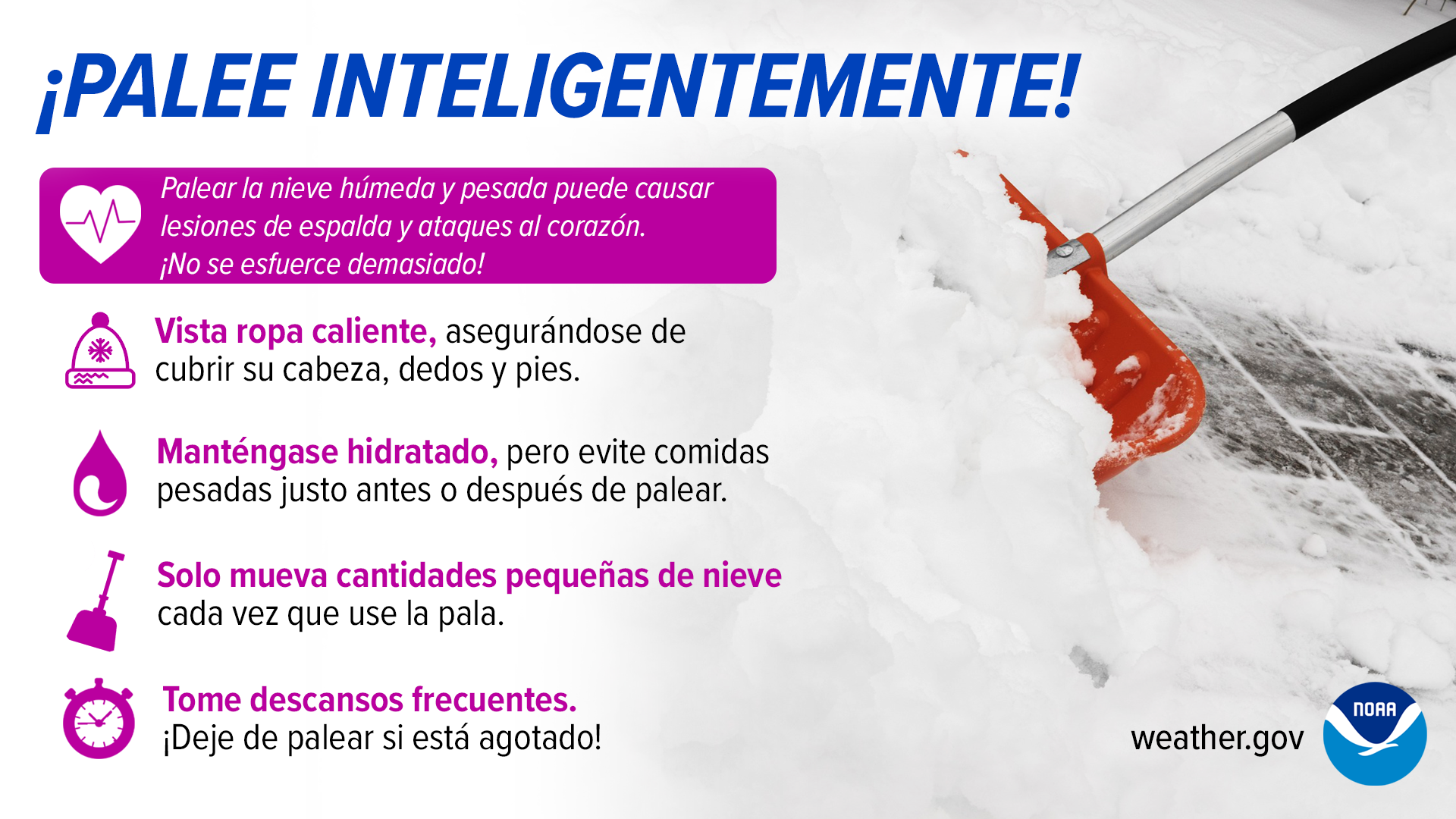
Contenido 5: Llantas de Camionetas y Vehículos Deportivos Utilitarios
Facebook: Incluso las camionetas y los vehículos deportivos utilitarios con tracción en las cuatro ruedas pueden perder tracción en la nieve. Manténgase Listo Meteorológicamente ejerciendo precaución adicional cuando maneje en condiciones invernales - sin importar qué vehículo esté manejando. Obtenga más información sobre seguridad para el invierno en: weather.gov/wrn/winter-storms-espanol-sm
X: Incluso las camionetas y vehículos deportivos utilitarios con tracción en las cuatro ruedas pueden perder tracción en la nieve. Manténgase #ListoMeteorologicamente ejerciendo precaución adicional cuando maneje en condiciones invernales - sin importar qué vehículo esté manejando
Alt Text: Las Camionetas y los Vehículos Deportivos Utilitarios pueden perder tracción en el hielo y la nieve. Incluso los vehículos de tracción en las cuatro ruedas pueden perder tracción en condiciones de mal tiempo. Todos los vehículos son susceptibles al hielo y la nieve. Conozca sus límites.
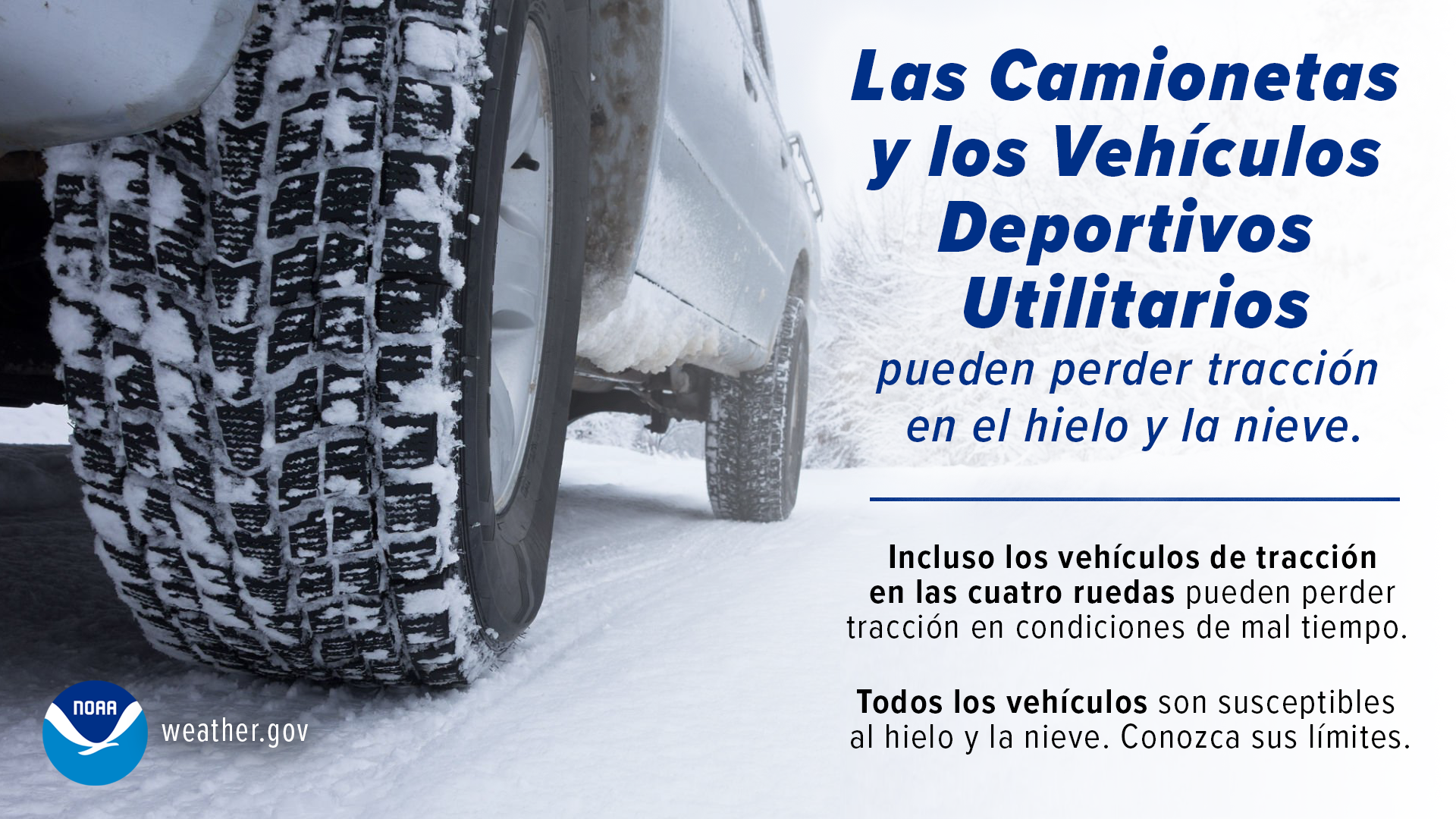
Contenido 6: Con Nieve y Hielo, Vaya Lento
Facebook: Manejar en invierno puede ser peligroso. Reduzca la velocidad para mantenerse a sí mismo y a otros seguros en la carretera. Recuerde, “con nieve y hielo, vaya lento.” Para más información: weather.gov/wrn/winter-storms-espanol-sm
X: Haga su parte para mantener a todos seguros en la carretera este invierno. Para más información: weather.gov/wrn/winter-storms-espanol-sm
Alt Text: CON NIEVE Y HIELO, VAYA LENTO. ¿Sabías que? (Did you know?) Cada año en los EE. UU., hay más de 1,000 muertos y 100,000 heridos debido a accidentes vehiculares durante condiciones invernales. Remueva la nieve en su vehículo antes de manejar. La nieve que se desprende de los autos causa accidentes. Vaya lento, y no utilice el control automático de velocidad. Las carreteras pueden estar resbaladizas incluso si solo se ven mojadas. Deje distancia adicional entre vehículos. Manténgase especialmente alejado de las máquinas quitanieves.
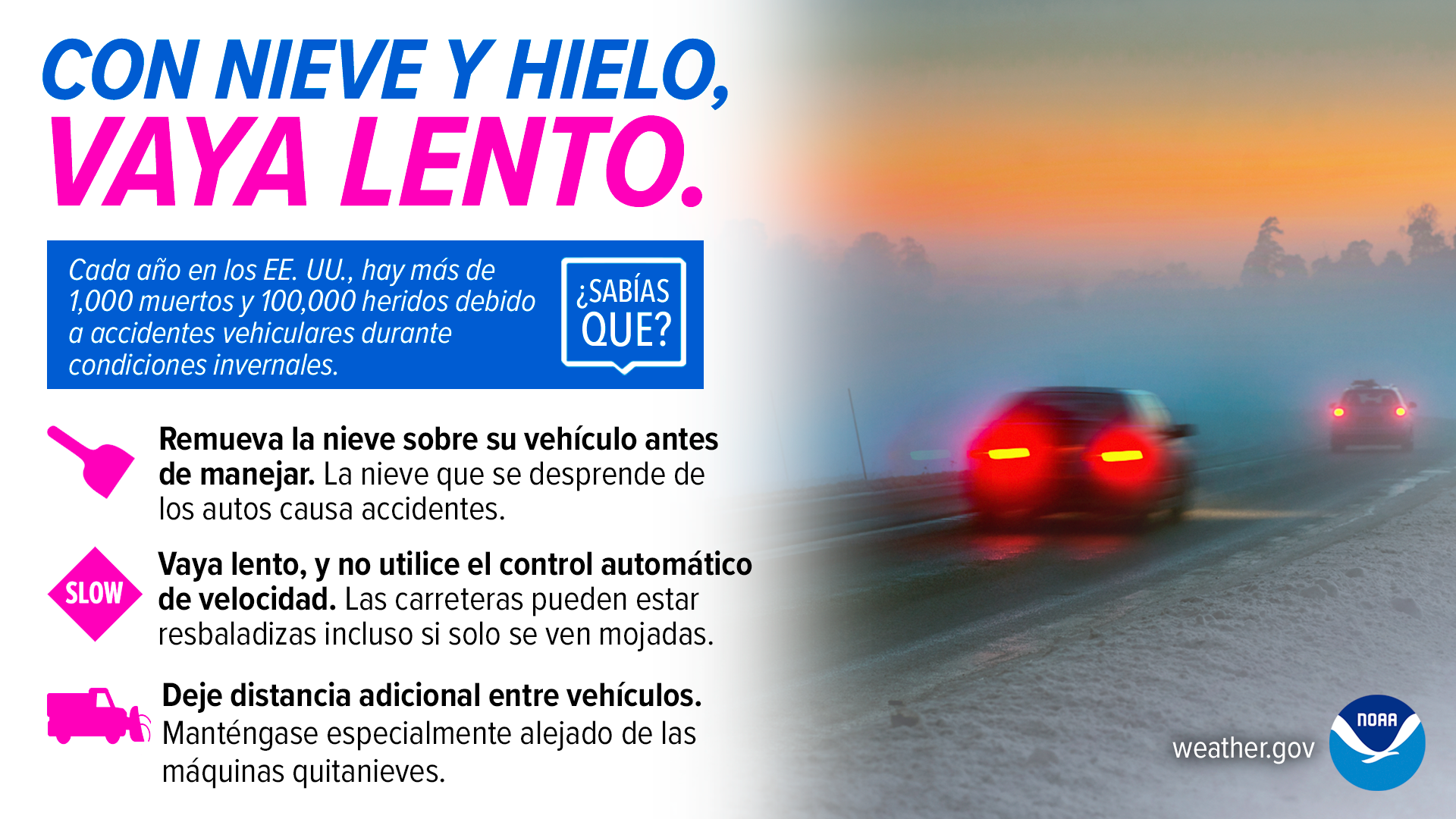
Contenido 7: No Subestime la Cellisca
Facebook: La cellisca puede ser engañosamente peligrosa - es mucho más densa que la nieve, así que palee con calma. Tome extrema precaución al conducir durante o después de la cellisca. Reduzca la velocidad, dejando una amplia distancia para frenar, y no use el control automático de velocidad. Obtenga más información sobre seguridad para el invierno en: weather.gov/wrn/winter-storms-espanol-sm
X: La cellisca es peligrosa - es mucho más densa que la nieve, así que palee con calma. Tome precaución al conducir durante/después de la cellisca. Reduzca la velocidad dejando una amplia distancia para frenar, y no use el control automático de velocidad. weather.gov/wrn/winter-storms-espanol-sm
Alt Text: No Subestime los Riesgos de la Cellisca. Palee con calma. La cellisca puede ser mucho más densa que la nieve. Vaya despacio y no se esfuerce demasiado. Tome extrema precaución al conducir. La cellisca puede causar condiciones peligrosas en la carretera y reducir la visibilidad. Reduzca la velocidad. Deje suficiente distancia para frenar. No use el control automático de velocidad.
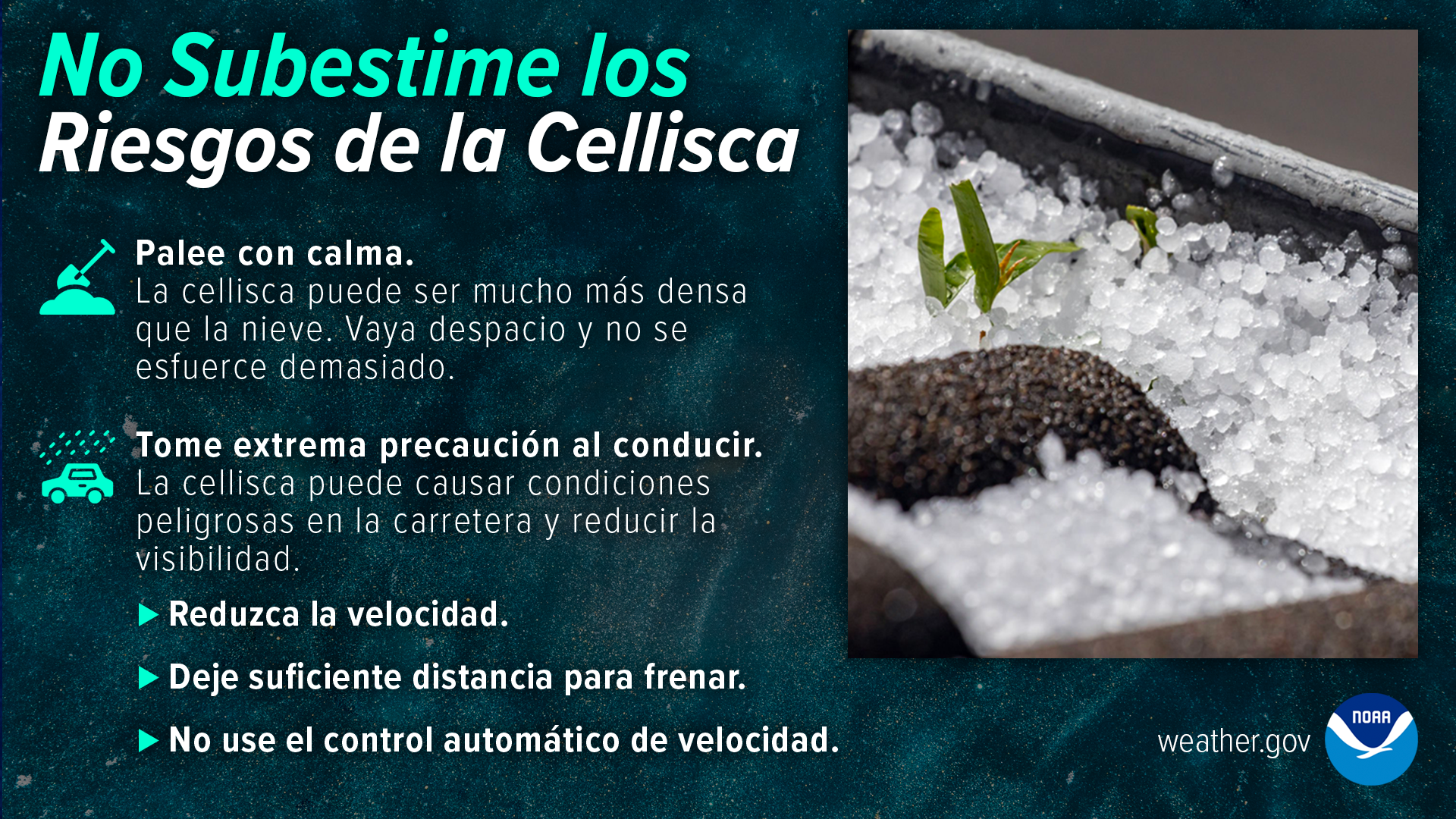
Contenido 8: Lluvia Helada
Facebook: Comparado con una tormenta de nieve típica, la lluvia helada es mucho más peligrosa - especialmente en carreteras. Aunque las dos son peligrosas, es mucho más fácil perder el control de tu vehículo sobre pavimento helado, al igual que el riesgo de caída de ramas y tendido eléctrico. En definitiva: No conduzcas cuando cae (o cayó recientemente) lluvia helada. weather.gov/wrn/winter-storms-espanol-sm
X: Comparado con una tormenta de nieve típica, la lluvia helada es mucho más peligrosa - especialmente en carreteras. En definitiva: No conduzcas cuando cae (o cayó recientemente) lluvia helada. weather.gov/wrn/winter-storms-espanol-sm
Alt Text: LLUVIA HELADA ES LO PEOR. La lluvia helada es más peligrosa que la nieve, ya que se puede formar hielo en el pavimento. Cuidado con la caída de ramas y tendido eléctrico. No conduzcas cuando cae (o cayó recientemente) lluvia helada.
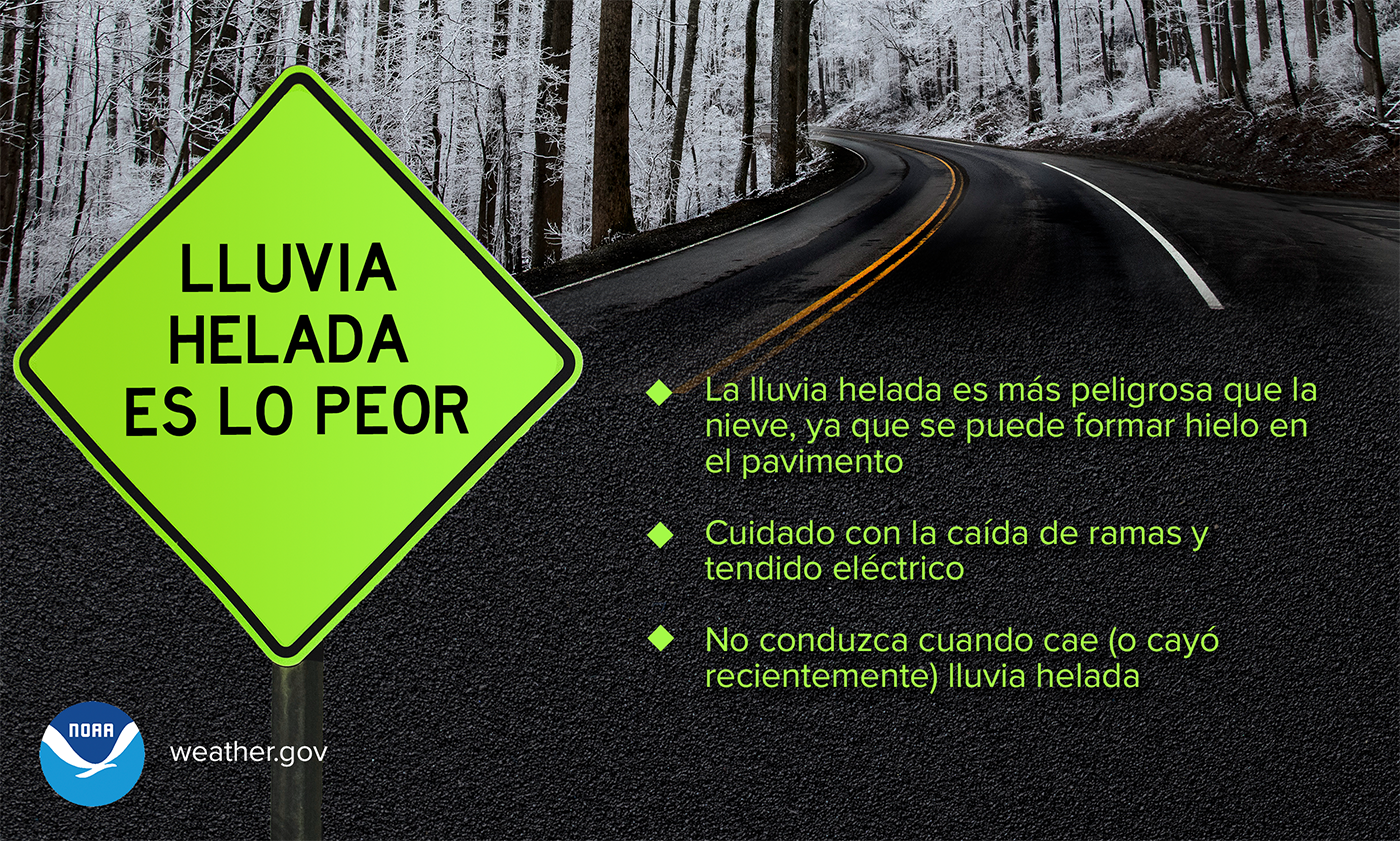
Contenido 9: Hielo Negro o Fino en Pavimento
Facebook: Cuando se mezclan temperaturas heladas con lluvia reciente o nieve derretida, se puede crear una capa fina de hielo - y podría ser casi invisible. Estas capas finas de hielo (o hielo negro) suelen ser más comunes por las noches, y pueden permanecer hasta la mañana. Evita conducir de ser posible...no dejes que te sorprenda. weather.gov/wrn/winter-storms-espanol-sm
X: ¡No dejes que te sorprenda el hielo fino en la carretera! Cuando se mezclan temperaturas heladas con lluvia reciente o nieve derretida, se puede crear una capa fina de hielo (o hielo negro) - y podría ser casi invisible. weather.gov/wrn/winter-storms-espanol-sm
Alt Text: NO DEJE QUE EL HIELO NEGRO LO TOME POR SORPRESA. Puede formarse en cualquier carretera, pero también en el borde de la acera y áreas de drenaje debido al derretimiento de la nieve. Es más frecuente en la noche, pero aún puede estar presente en la mañana. No conduzca durante temperaturas congelantes después de la lluvia o derretimiento de la nieve.

Contenido 10: ¡No Se Resbale!
Facebook: Resbalarse en una acera helada puede provocar lesiones graves o incluso la muerte, especialmente en el caso de las personas mayores. Ayude a prevenir la formación de hielo colocando sal en las aceras y apagando los rociadores antes de que lleguen las condiciones frías. Obtenga más información sobre seguridad en el hielo en: weather.gov/wrn/winter-storms-espanol-sm
X: Resbalarse en una acera helada puede provocar lesiones graves o incluso la muerte, especialmente en el caso de las personas mayores. Ayude a prevenir la formación de hielo colocando sal en las aceras y apagando los rociadores antes de que lleguen las condiciones frías.
Alt Text: ¡No Se Resbale! ¡Las superficies heladas pueden provocar lesiones graves! Ayude a prevenir el hielo colocando sal en las aceras y apagando los rociadores antes de la llegada del frío. Camine sobre superficies tratadas o sin hielo con mejor tracción, si es posible. Utilice calzado de invierno adecuado con suelas de goma. Tome pasos lentos y cortos para poder reaccionar ante condiciones heladas.
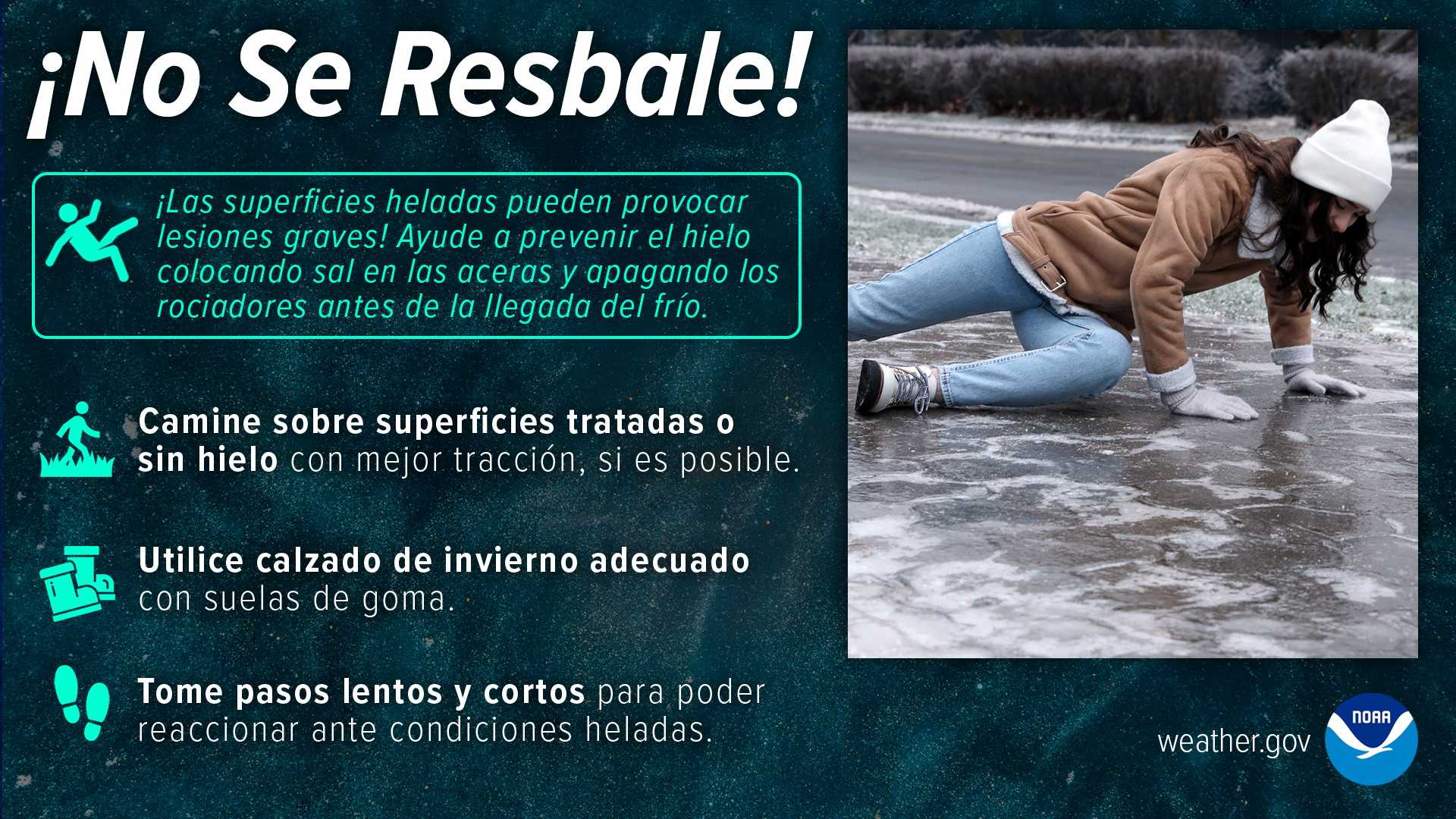
Contenido 11: Seguridad en Hielo
Facebook: El hielo nunca es completamente seguro. Sepa qué tan grueso es el hielo y manténgase alejado de las grietas o hielo derritiéndose. Si no lo sabe, ¡no vaya! weather.gov/wrn/winter-storms-espanol-sm
X: El hielo nunca es completamente seguro. Sepa qué tan grueso es el hielo y manténgase alejado de las grietas o hielo derritiéndose. Si no lo sabe, ¡no vaya! weather.gov/wrn/winter-storms-espanol-sm
Alt Text: SEGURIDAD SOBRE HIELO El hielo nunca es 100% seguro. ¡Si no sabes, no vayas! Guías del grosor mínimo del hielo solo son válidas para hielo nuevo y claro: < 2 pulgadas…¡NO PISE! 4 pulgadas…Soporta una persona pescando o caminando 5 pulgadas…Soporta un pequeño grupo patinando 6 pulgadas…Soporta una motonieve 9 pulgadas…Soporta coches 12 pulgadas…Soporta camionetas medianas Manténgase alejado de grietas y hielo que se esté derritiendo.

Contenido 12: Ciencia de la Sensación Térmica
Facebook: Aire extremadamente frío llega cada invierno para al menos parte del país y afecta a millones de personas en los Estados Unidos. El aire ártico, junto con vientos fuertes, puede causar una sensación térmica muy peligrosa. https://www.weather.gov/wrn/winter-storms-espanol-sm Encuentra un refugio con calefacción cerca de ti enviando un mensaje de texto SHELTER y un código postal al 43362 (ex: Shelter 63139)
X: El aire ártico, junto con vientos fuertes, puede causar una sensación térmica muy peligrosa. Encuentra un refugio con calefacción cerca de ti enviando un mensaje de texto SHELTER y un código postal al 43362 (ex: Shelter 63139). weather.gov/wrn/winter-storms-espanol-sm
Alt Text: La Ciencia de la Sensación Térmica. Sin Viento: 98.6F La temperatura promedio del cuerpo humano. Bajo condiciones tranquilas, el cuerpo irradia calor, creando una capa de calor entre nuestra piel y el aire frío a nuestro alrededor. Con Viento: 95F Hipotermia comienza cuando nuestra temperatura corporal baja de dos a cuatro grados. Pero cuando hay viento, el aire en movimiento rompe esa capa aislante. Esto acelera la pérdida de calor quitando el calor de nuestra piel. Calor es removido de nuestros cuerpos.
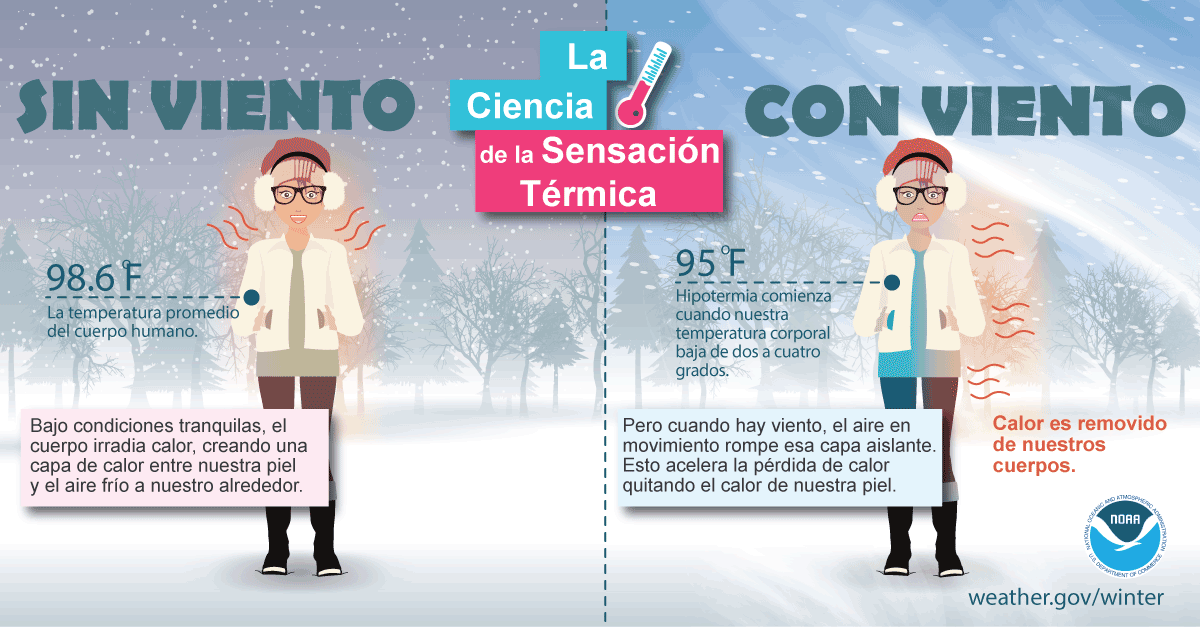
Contenido 13: Cronología de Planificación Ante Tormentas Invernales
Facebook: ¿Está preparado para una tormenta invernal? Si el pronóstico prevé condiciones del tiempo invernales, comience a prepararse AHORA. No espere hasta el último minuto. weather.gov/wrn/winter-storms-espanol-sm
X: ¿Está preparado para una tormenta invernal? Si el pronóstico prevé condiciones del tiempo invernales, comience a prepararse AHORA. No espere hasta el último minuto. #ListoMeteorológicamente weather.gov/wrn/winter-storms-espanol-sm
Alt Text: Cronología de Planificación Ante Tormentas Invernales. Unos días antes: Si el pronóstico indica tiempo invernal, comience a prepararse ahora. Tenga suministros de emergencias para su casa y carro. Verifique los detectores de humo y de monóxido de carbono. Llene de combustible su auto y fuentes de calefacción. El día antes: La precisión del pronóstico continúa mejorando,así que manténganse monitoreando las actualizaciones. Ajuste sus planes. Tenga múltiples maneras de recibir los Avisos. Traiga las mascotas al interior y asegúrese de que tengan agua. Durante y después: Permanezca vigilante y manténgase informado. Maneje solo de ser necesario. Verifique a su familia y vecinos. Ventile adecuadamente las fuentes de calefacción de emergencia. Mantenga los generadores al menos a 20 pies de distancia de su casa. Tómelo con calma cuando palee.

Contenido 14: Congelación e Hipotermia - Conozca Sus Acciones
Facebook: ¿Está frío afuera? Evite el riesgo de congelación e hipotermia vistiéndose en capas, cubriendo la piel expuesta y limitando el tiempo al aire libre. Si alguien podría estar experimentando alguna de estas condiciones, busque atención médica de inmediato y conozca sus acciones. weather.gov/wrn/winter-storms-espanol-sm
X: ¿Está frío afuera? Evite el riesgo de congelación e hipotermia vistiéndose en capas, cubriendo la piel expuesta y limitando el tiempo al aire libre. Si alguien podría estar experimentando alguna de estas condiciones, busque atención médica de inmediato y conozca sus acciones.
Alt Text: Congelación e Hipotermia: Conozca Sus Acciones. Si alguien podría estar experimentando congelación o hipotermia, ¡busque atención médica de inmediato! Diríjase a un área cálida. Remueva la ropa mojada. Caliéntese con capas secas de cobijas o ropa. Coloque la piel afectada por la congelación en agua cálida (NO caliente). Precaución de Congelación: No utilice chimeneas o fuentes de calor artificiales para calentarse. No frote o ponga presión sobre las áreas congeladas.
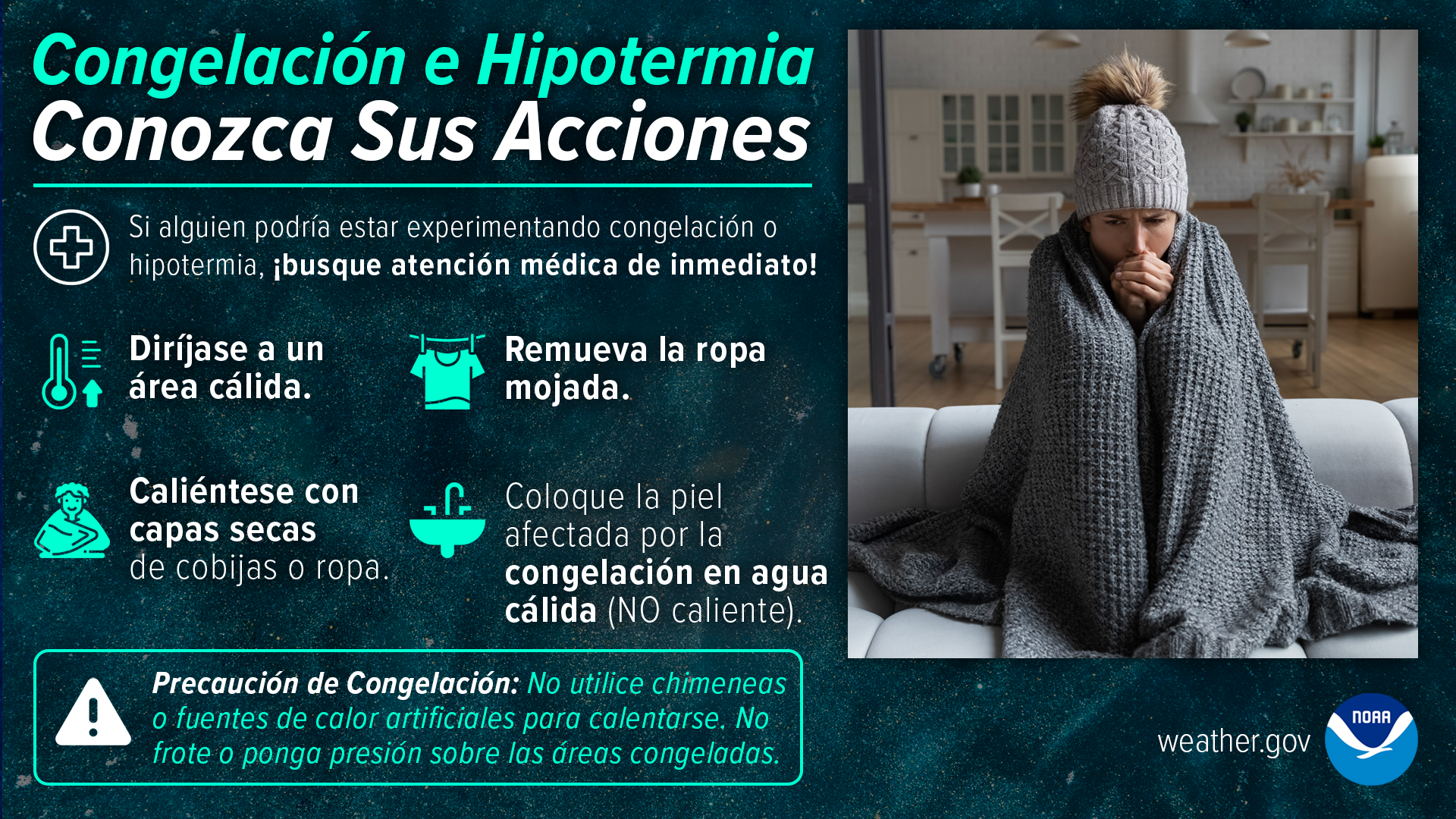
❄️Winter Preparedness (ASL)
More resources for those who are Deaf and Hard of Hearing: https://www.weather.gov/wrn/dhh-safety
Post 1: Winter Weather Hazards and Safety Tips
Facebook: Winter storms can be just as hazardous as any other type of weather, and it's important to be prepared. Learn how to prepare NOW with this video in American Sign Language. youtu.be/ljABZKcL-Ls
X: Winter storms can be just as hazardous as any other type of weather, and it's important to be prepared. Learn how to prepare NOW with this video in American Sign Language. #WeatherReady #ASL youtu.be/ljABZKcL-Ls
Post 2: Winter Storm Kit
Facebook: If a winter storm is forecast for your area, make sure you have these items prepared. A flashlight, shovel, salt, water bottles, blankets, portable charger, extra hearing aid batteries, pen and paper for communication, and weather radio with deaf accessible attachments.
X: If a winter storm is forecast, make sure you have these items prepared. A flashlight, shovel, salt, water bottles, blankets, portable charger, extra hearing aid batteries, pen and paper for communication, and weather radio with deaf accessible attachments. #WeatherReady
Alt Text: Preparing for a winter storm. If a winter storm is forecasted for your area, make sure you have these items prepared. A flashlight, shovel, salt, water bottles, blankets, portable charger, extra hearing aid batteries, pen and paper for communication, and weather radio with deaf accessible attachments.

Post 2: Preparing for a Winter Storm
Facebook: If a winter storm is forecast, make sure you are prepared. Gather supplies, reschedule activities on the storm date, and gas up your car.
X: If a winter storm is forecast, make sure you are prepared. Gather supplies, reschedule activities on the storm date, and gas up your car. #WeatherReady #mowx #ilwx
Alt Text: If a winter storm is forecast, make sure you are prepared. Gather supplies, reschedule activities on the storm date, and gas up your car.

Post 2: Preparing for a Winter Storm
Facebook: Ice on the road can be hard to see and make driving dangerous. Slow down and increase the distance between cars.
X: Ice on the road can be hard to see and make driving dangerous. Slow down and increase the distance between cars. #WeatherReady #mowx #ilwx
Alt Text: Ice on the road can be hard to see and make driving dangerous. Slow down and increase the distance between cars.

Post 2: General Safety and Preparedness Tips
Facebook: Having a plan is important in times of emergency, and this includes building an emergency preparedness kit before a disaster. Learn how with this video in American Sign Language. youtu.be/XWEvqy0e9-0
X: Having a plan is important in times of emergency, and this includes building an emergency preparedness kit before a disaster. Learn how with this video in American Sign Language. #WeatherReady #ASL youtu.be/XWEvqy0e9-0
🌪️Severe Weather Safety
Post 1: Have a Plan
Facebook: Make a severe weather plan before you need it! Your family may not be together when a disaster strikes so it is important to plan in advance: how you will get to a safe place; how you will contact one another; how you will get back together; and what you will do in different situations. To find out how, visit https://ready.gov/make-a-plan #SpringSafety
X: How will you stay in touch during a disaster? Make a plan! https://ready.gov/make-a-plan #SpringSafety #mowx #ilwx
Alt Text: Family sitting together working through paperwork. Make a severe weather plan, find out how at ready.gov/make-a-plan.
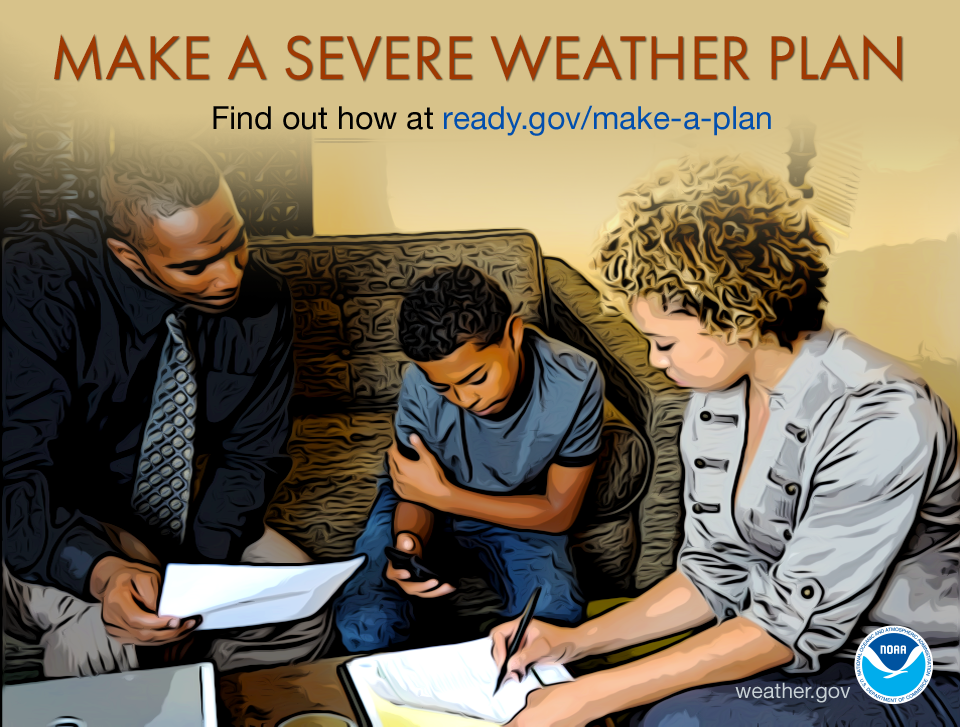
Post 2: National Weather Service Severe Weather Operations
Facebook: When severe weather threatens eastern Missouri and southwest Illinois the National Weather Service in St. Louis goes into severe weather operations. Additional staff is needed to meet all the needs of the 46 counties we serve including warning teams, a decision support meteorologist, and warning coordinator. Each of these folks ensure that warnings are timely and accurate, and weather hazards are communicated to emergency managers, broadcast media, and the public. https://youtu.be/XqP0cvXH14c?si=c-HCLpHGZkZhWNdd
X: When severe weather threatens eastern Missouri and southwest Illinois the National Weather Service in St. Louis goes into severe weather operations. Learn more about what this looks like in this video: https://youtu.be/XqP0cvXH14c?si=c-HCLpHGZkZhWNdd #mowx #ilwx #midmowx #stlwx
Alt Text: Over the years, many have had the opportunity to tour our facility and get an inside look at our operations. However, the operational environment quickly changes in preparation for severe weather. This video provides an inside look at some of the positions employed to successfully meet our mission.
Post 3: Chances of being struck by lightning
Facebook: Do you golf, grill, or garden? Each year in the United States, thunderstorms produce 20-25 million lightning flashes that strike the ground, killing an average of 20+ people and injuring hundreds more - often in devastating and permanent ways. weather.gov #mowx #ilwx
X: Each year in the United States, thunderstorms produce 20-25 million lightning flashes that strike the ground, killing an average of 20+ people and injuring hundreds more - often in devastating and permanent ways. weather.gov #mowx #ilwx
Alt Text: Your chance of being struck by lightning greatly increases when remaining outdoors during a thunderstorm. Lightning can strike from up to 10 miles away. When thunder roars, go indoors! See a flash, dash inside! Some of the activities people were doing when they were recently struck by lightning include: golfing, boating, running, grilling, walking, construction, riding (motorcycles), gardening swimming.

Post 4: Tornadoes and Road Safety
Facebook: During a tornado, seeking refuge in a vehicle or under an overpass is NOT safe. If you are outside during a tornado warning, the best option is to drive to a designated shelter, basement, or safe room. weather.gov/safety/tornado #mowx #ilwx
X: During a tornado, seeking refuge in a vehicle or under an overpass is NOT safe. If you are outside during a tornado warning, the best option is to drive to a designated shelter, basement, or safe room. weather.gov/safety/tornado #WeatherReady #mowx #ilwx
Alt Text: TORNADOES AND ROAD SAFETY. 1) What To Do: Get off the road. The best option is to drive to a designated shelter, basement or safe room. The next best option is a small, windowless room or hallway on the lowest floor of a sturdy building. 2) What No To Do: Do not seek refuge in a vehicle, outside or under an overpass. A highway overpass does not provide safety from a tornado. Do not seek shelter under an overpass or a tree. This puts you at greater risk of being killed or seriously injured by flying debris from the powerful tornadic winds.

Post 5: Hail Can Damage Property and People
Facebook: Some thunderstorms can produce hail, balls of ice ranging from pea sized to larger than grapefruits. Hail that is larger than one inch in diameter, about the size of a US quarter, are dangerous to the human body and to property. The best place to be during a thunderstorm and hail is inside, away from windows. #mowx #ilwx
X: Some thunderstorms can produce hail, balls of ice ranging from pea sized to larger than grapefruits. Hail bigger than a US quarter dangerous to the human body and to property. The best place to be during a thunderstorm and hail is inside, away from windows. #mowx #ilwx
Alt Text: Hail Size Chart - while the National Weather Service encourages the actual measurements of hail size, oftentimes, an object-to-size conversion can provide important information about hail that fall from thunderstorms. Below you will find a list of common objects used to describe the diameter of observed hail. Pea: 0.25 inches. Penny: 0.75 inches. Quarter: 1.00 inches. Ping pong ball: 1.50 inches. Gold ball: 1.75 inches. Lime: 2.00 inches. Tennis Ball: 2.50 inches. Baseball: 2.75 inches. Softball: 4:00 inches. Grapefruit: 4.50 inches. weather.gov
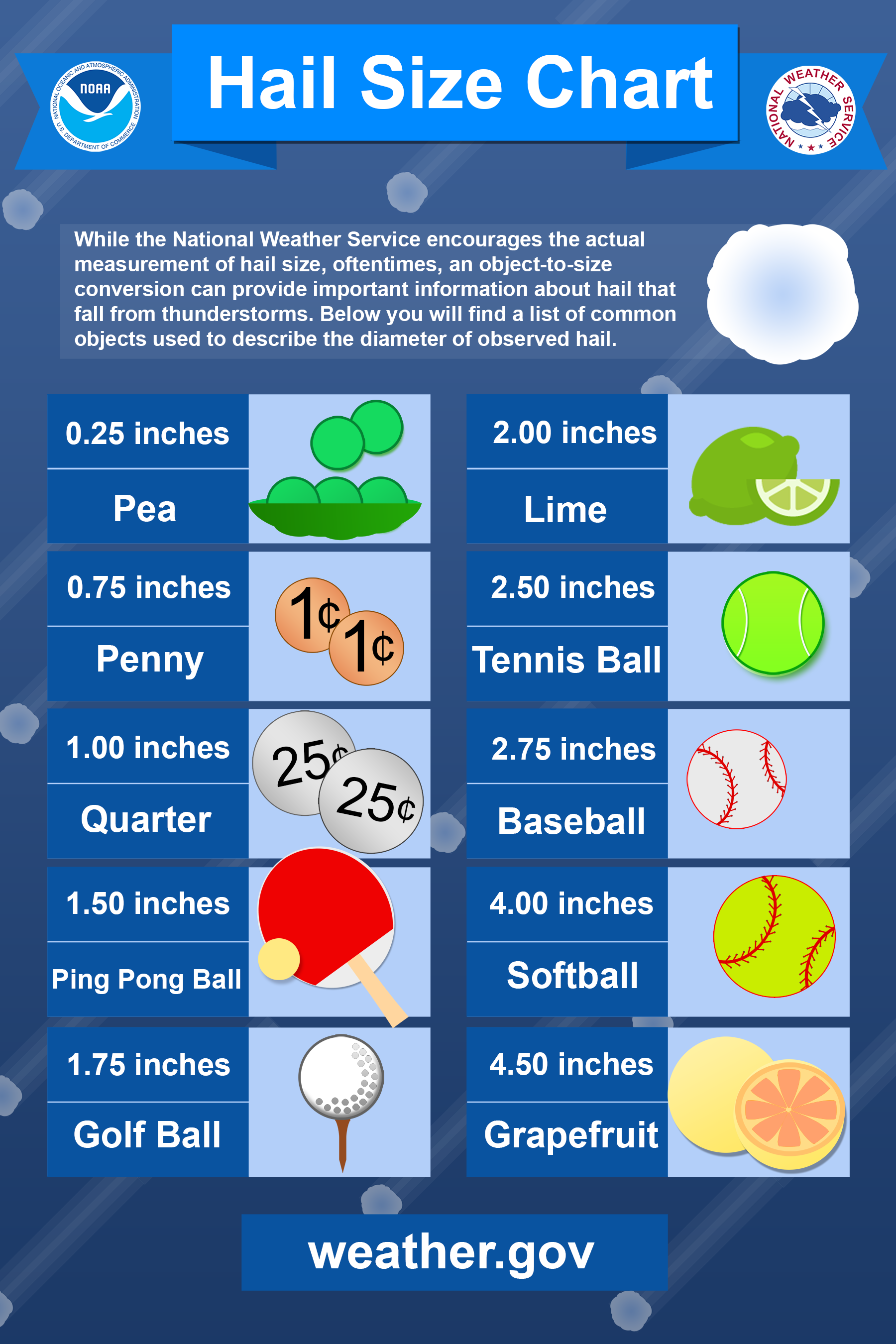
Post 6: Your Safe Place from Extreme Wind
Facebook: During high winds, tree damage is expected, and loose objects can become airborne and dangerous. You are safest indoors, away from windows, in an interior room. Stay Weather-Ready and learn more about wind safety: weather.gov/safety/wind #mowx #ilwx
X: During high winds, tree damage is expected, and loose objects can become airborne and dangerous. You are safest indoors, away from windows, in an interior room. Stay #WeatherReady and learn more about wind safety: weather.gov/safety/wind #mowx #ilwx
Alt Text: Your safe place from extreme wind: during high winds, tree damage is expected. You are safest indoors, away from windows, in an interior room. Prevent damage to your property by trimming loose branches and parking away from trees.
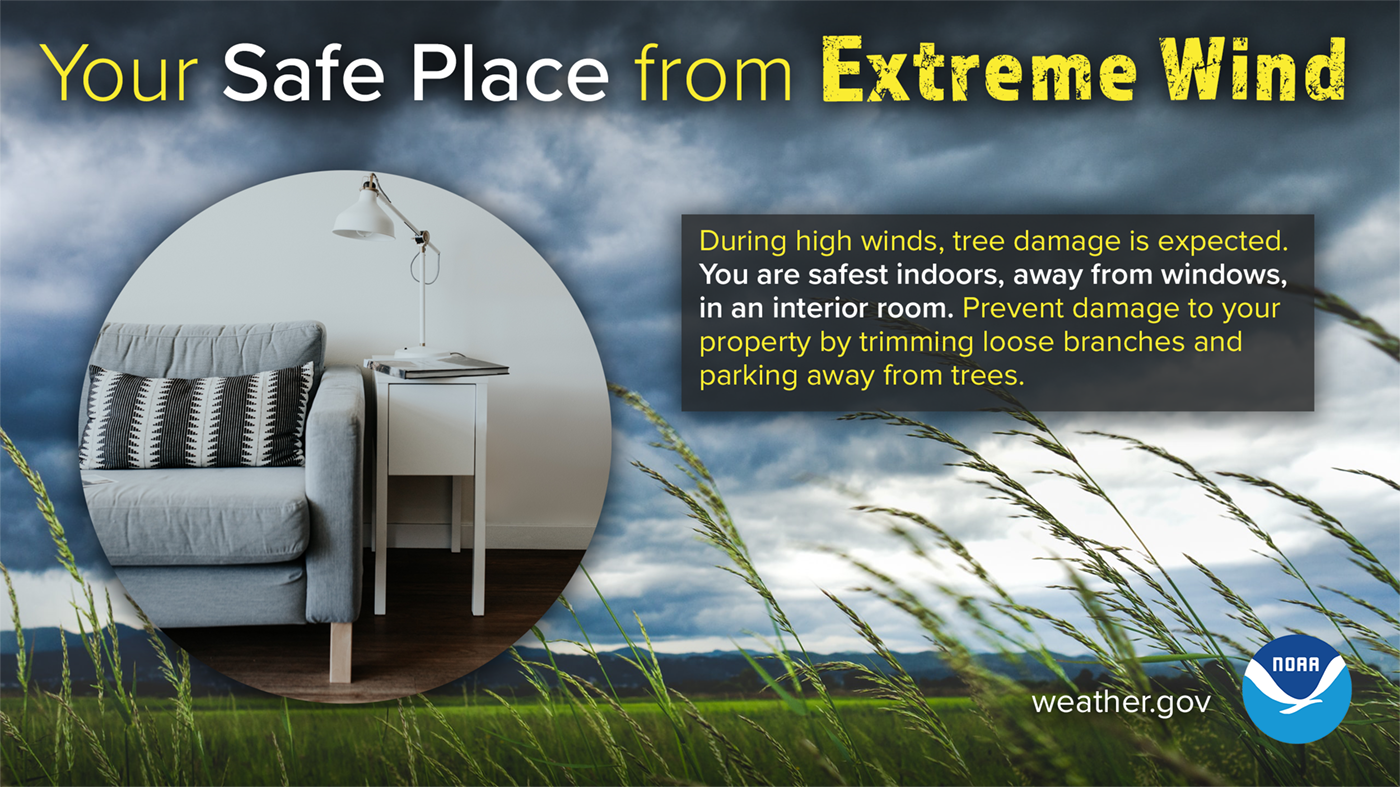
Post 7: What Weather-Ready Looks Like: Floods
Facebook: What does being Weather-Ready look like? When it comes to flood safety, it means knowing to never drive around barricades or through flooded roads, which are the cause of most flood fatalities. Learn more flood safety tips at weather.gov/safety/flood #mowx #ilwx
X: What does being #WeatherReady look like? When it comes to flood safety, it means knowing to never drive around barricades or through flooded roads, which are the cause of most flood fatalities. Learn more flood safety tips at weather.gov/safety/flood #mowx #ilwx
Alt Text: What does Weather-Ready look like? During floods: Motorists who never drive around barricades or through flooded roads.
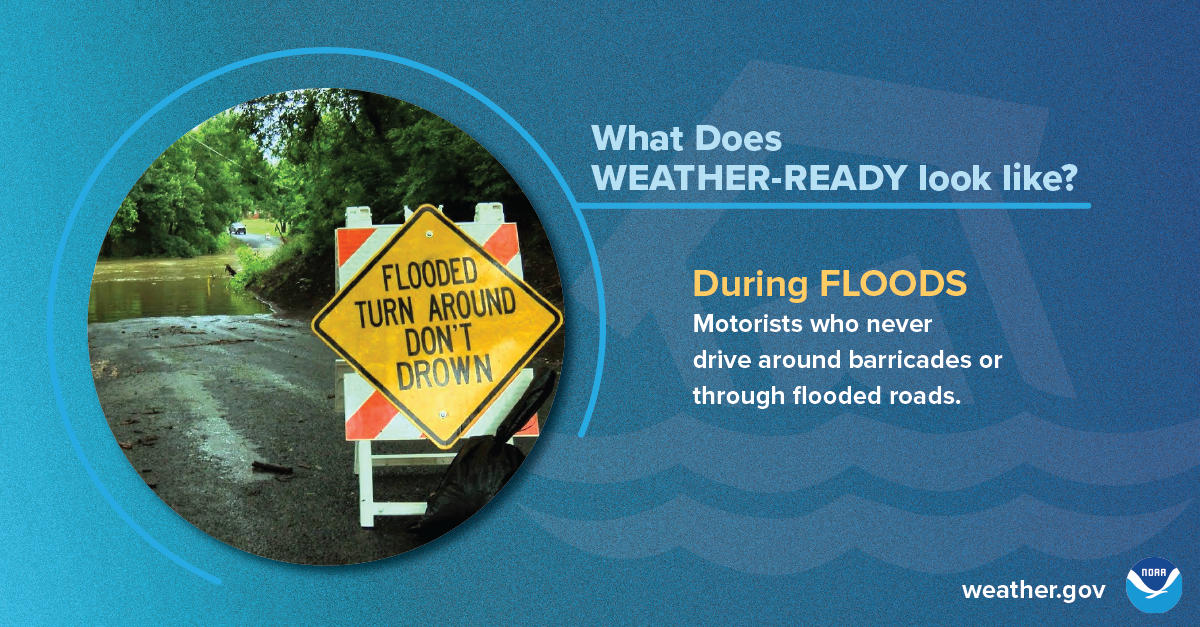
Post 8: Survivor Story: Flood
Facebook: "I would have surely lost the vehicle and maybe our lives...just saying 'Turn Around Don't Drown' saved life and property." You never know if the road is even below that muddy water anymore. weather.gov/safety/flood-turn-around-dont-drown
X: "I would have surely lost the vehicle and maybe our lives...just saying 'Turn Around Don't Drown' saved life and property." You never know if the road is even below that muddy water anymore. weather.gov/safety/flood-turn-around-dont-drown #WeatherReady #mowx #ilwx
Alt Text: I was driving a half-ton 4x4 which provides some comfort about not getting stuck in the mud. As I drove down the dirt road, I came across a low-water cement bridge. The bridge was completely covered in water, but not deep. I made a critical decision to turn around and drive the long way around to another highway. The next morning the water had receded and there was a huge hole — the water had washed away the dirt where the road met the cement. I would have surely lost the vehicle and maybe our lives…just saying “Turn Around and Don’t Drown” saved life and property. -- Julie, Nashville, TN, 2018
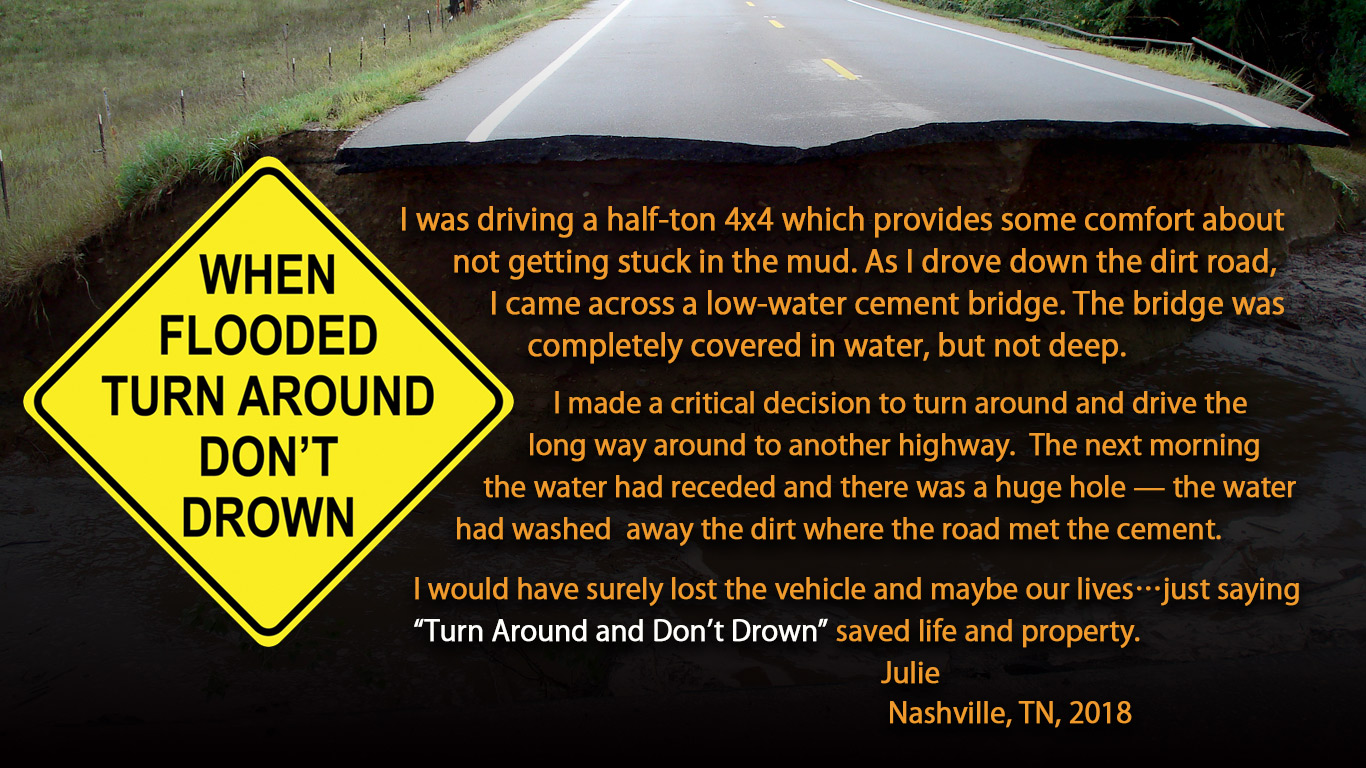
🌪️Seguridad Contra Tormentas Eléctricas
Contenido 1: Artículos de Emergencia
Facebook: Necesitará acceso fácil a muchos artículos de emergencia en caso de un evento meteorológico extremo. Además de las necesidades básicas de supervivencia, no olvide otros suministros tales como cargadores y productos de higiene, o documentos personales y de propiedad importantes. Tenga una mochila de viaje lista para llevar cosas con usted si necesita irse de prisa.
X: Necesitará fácil acceso a muchos artículos de emergencia en caso de tiempo extremo. Además de necesidades básicas de supervivencia, no olvide otros suministros como cargadores y productos de higiene, o documentos personales y de propiedad importantes. #ListoMeteorológicamente
Alt Text: Preparación para Condiciones Meteorológicas Extremas: Artículos de Emergencia. Necesidades de supervivencia: equipo de primeros auxilios, medicinas, comida y agua (incluya para las mascotas). Otros suministros: cargadores y baterías, radio, productos de higiene, dinero en efectivo. Documentos importantes: prueba de propiedad, póliza de seguros / médico, identificación personal. Mochila de viaje lista en caso de evacuación.
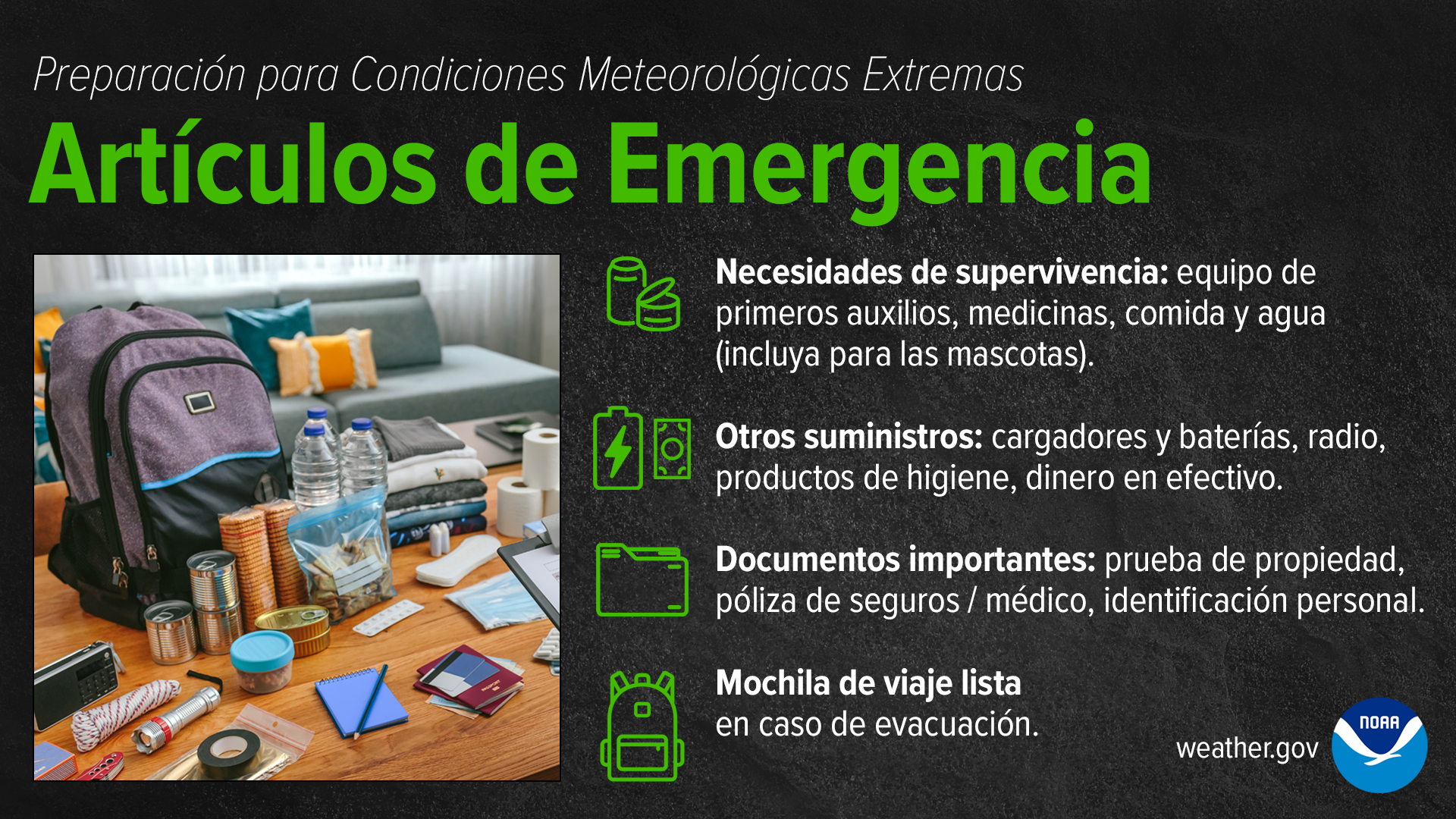
Contenido 2: Probabilidades de ser impactado por un rayo
Facebook: Cada año en los Estados Unidos, las tormentas eléctricas producen 20-25 millones de rayos que impactan en el suelo, matando a un promedio de 20+ personas e hiriendo a centenares más - a menudo de manera devastadora y permanente. https://www.weather.gov/wrn/thunderstorm-espanol-sm
X: Cada año en los Estados Unidos, las tormentas eléctricas producen 20-25 millones de rayos que impactan en el suelo, matando a un promedio de 20+ personas e hiriendo a centenares más - a menudo de manera devastadora y permanente. weather.gov/wrn/thunderstorm-espanol-sm
Alt Text: Las probabilidades de ser impactado por un rayo aumentan grandemente cuando se queda al aire libre durante una tormenta eléctrica. Los rayos pueden impactar desde hasta 10 millas de distancia de la tormenta. ¡Cuando escuche el trueno, busque refugio! Si ve un relámpago, diríjase adentro. Algunas de las actividades al aire libre que personas realizaban cuando fueron impactadas por un rayo incluyen: Jugando golf, Parrillando, Andando en moto, Navegando en barco, Caminando, Realizando jardinería, Corriendo, Trabajando en construcción, Nadando.

Contenido 3: Tornados y Seguridad Via
Facebook: Durante un tornado, buscar refugio en un vehículo o bajo un puente NO es seguro. Si está al aire libre durante un aviso de tornado, la mejor opción es conducir a un refugio designado, sótano o una habitación segura. https://www.weather.gov/wrn/tornado-espanol-sm #SpringSafety #mowx #ilwx
X: Durante un tornado, buscar refugio en un vehículo o bajo un puente NO es seguro. Si está al aire libre durante un aviso de tornado, la mejor opción es conducir a un refugio designado, sótano o una habitación segura. https://www.weather.gov/wrn/tornado-espanol-sm
Alt Text: Tornados y Seguridad Vial Qué Hacer: Salga de la carretera. La mejor opción es conducir a un refugio designado, sótano, o una habitación segura. La siguiente mejor opción es una habitación pequeña o pasillo sin ventanas en el piso más bajo de un edificio seguro. No Qué Hacer: No busque refugio en un vehículo, al aire libre o bajo un puente. Un puente no ofrece protección ante un tornado. No busque refugio bajo un puente o árbol. Esto lo pone en mayor riesgo de perder la vida o herirse gravemente debido a escombros lanzados por el tornado.
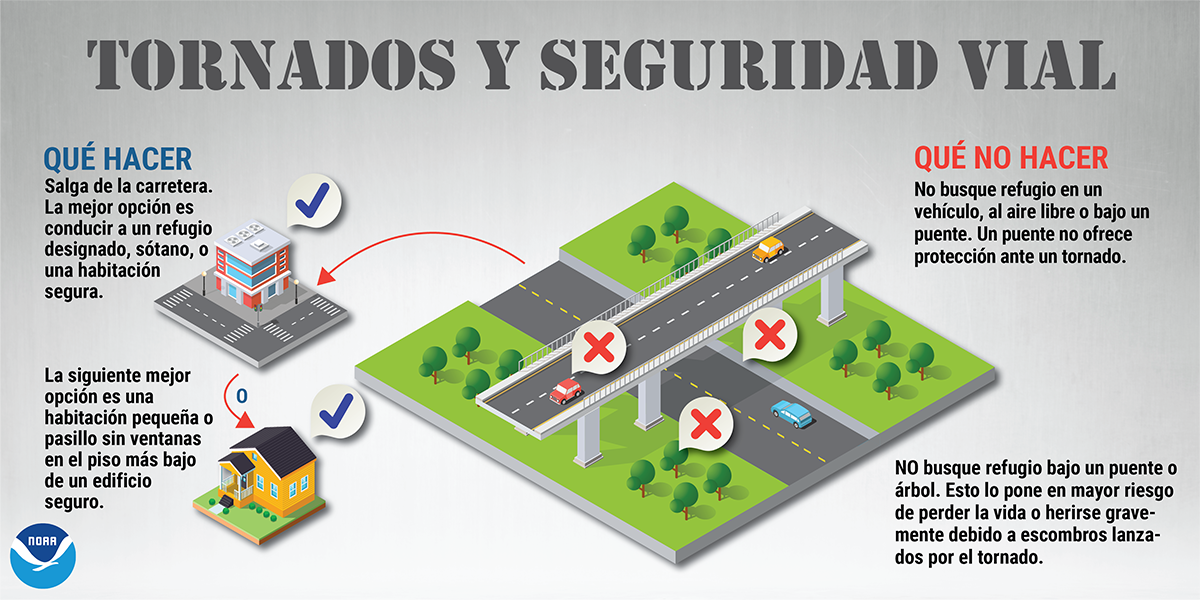
Contenido 4: Las Tormentas Eléctricas pueden escalar rápidamente
Facebook: Las tormentas y turbonadas pueden tornar el cielo despejado a oscuro rápidamente. Manténgase Listo Meteorológicamente configurando su teléfono para recibir alertas del tiempo, y manténgase seguro dirigiéndose inmediatamente al interior cuando el cielo se torne amenazante. https://www.weather.gov/wrn/tornado-espanol-sm
X: Los cielos despejados pueden tornarse oscuros y amenazantes rápidamente, debido a tormentas emergentes o turbonadas. iEsté preparado! https://www.weather.gov/wrn/tornado-espanol-sm
Alt Text: Las Tormentas Eléctricas pueden escalar rápidamente. Los cielos despejados pueden tornarse oscuros y amenazantes rápidamente, debido a tormentas emergentes o turbonadas. iEsté preparado! Configure una manera de recibir alertas del tiempo en su teléfono. Cuando se le alerte sobre una tormenta, muévase al interior de un edificio robusto inmediatamente. Manténgase alejado de las ventanas cuando esté adentro. Si no hay edificio cerca, vaya dentro de un vehículo.
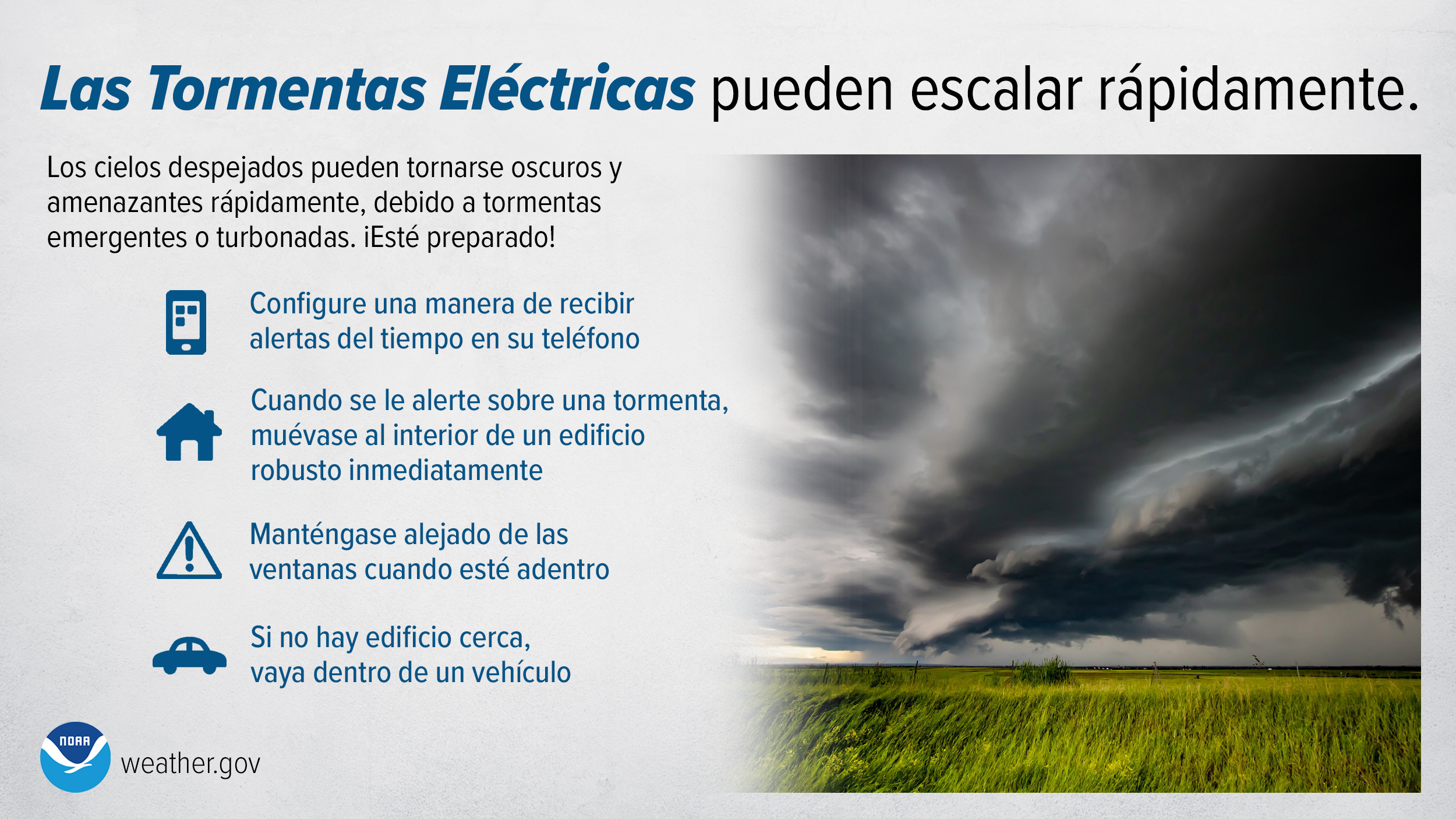
Contenido 5: Nunca conduzca alrededor de barricadas
Facebook: ¡NUNCA conduzca alrededor de barricadas hacia aguas de inundación! Más del 50% de las muertes debido a inundaciones están relacionadas a vehículos. Solo toma 12 pulgadas de agua en rápido movimiento para arrastrar a un auto pequeño con la corriente y 18 pulgadas para llevarse a un vehículo grande. ¡Dé la vuelta, no se ahogue! https://www.weather.gov/wrn/tornado-espanol-sm
X: ¡NUNCA conduzca alrededor de barricadas! Más del 50% de las muertes debido a inundaciones están relacionadas a vehículos. Solo toma 12" de agua en rápido movimiento para arrastrar a un auto pequeño y 18" para llevarse a un vehículo grande. ¡Dé la vuelta, no se ahogue! https://www.weather.gov/wrn/tornado-espanol-sm
Alt Text: NUNCA CONDUZCA ALREDEDOR DE BARRICADAS. La mayoría de las muertes ocurren en vehículos. Usted no sabe cuán profunda está el agua. Incluso cuando el agua retrocede, el terreno puede estar inestable.

🌪️Severe Weather Safety (ASL)
More resources for those who are Deaf and Hard of Hearing: https://www.weather.gov/wrn/dhh-safety
Post 1: Have a Plan
Facebook: Having a plan established ahead of severe weather is essential for staying safe and calm. Learn how to prepare NOW with this video in American Sign Language. https://youtu.be/XcXwNN0yZJk
X: Having a plan established ahead of severe weather is essential for staying safe and calm. Learn how to prepare NOW with this video in American Sign Language. #WeatherReady #ASL https://youtu.be/XcXwNN0yZJk
Post 2: Lightning Safety
Facebook: No where outside is safe during a thunderstorm. See a flash? Dash inside! Learn more with this video in American Sign Language. https://youtu.be/bZFSEaJRJ3U
X: No where outside is safe during a thunderstorm. See a flash? Dash inside! Learn more with this video in American Sign Language. #WeatherReady #ASL https://youtu.be/bZFSEaJRJ3U
Post 3: Lightning Safety
Facebook: ractice lightning safety, get inside a sturdy building or enclosed vehicle. Stay away from windows, plumbing, and outlets. #mowx #ilwx #WeatherReady #ASL
X: Practice lightning safety, get inside a sturdy building or enclosed vehicle. Stay away from windows, plumbing, and outlets. #mowx #ilwx #WeatherReady #ASL
Alt Text: No where outside is safe during a thunderstorm because of lightning. Practice lightning safety. Stay away from windows, wires, metal plumbing, water, electronics, outlets, and corded phones. Seek good shelter in a sturdy building or hard topped enclosed vehicle. Never use trees, golf carts, pavilions, dugouts, or sheds as shelter.

Post 4: Tornado Watch v. Warning
Facebook: Know the difference between a Tornado Watch and Tornado Warning. A Tornado Watch means a tornado is possible, be prepared and ready to act. A Tornado Warning means a tornado is happening or about to happen, take shelter immediately! #mowx #ilwx #WeatherReady #ASL
X: Know the difference between a Tornado Watch and Tornado Warning. A Tornado Watch means a tornado is possible, be prepared and ready to act. A Tornado Warning means a tornado is happening or about to happen, take shelter immediately! #mowx #ilwx #WeatherReady #ASL
Alt Text: Understand the difference between a Tornado Watch and a Tornado Warning. A Tornado Watch is issued when a tornado is possible. Know your safe place (a storm shelter or basement). Be ready to act quickly if a warning is issued. Be prepared! A Tornado Warning is issued when a tornado is happening or about to happen. Immediately seek shelter in your safe place. Take Action!

Post 5: Tornado Safety
Facebook: Know where to go during a tornado! Learn more with this video in American Sign Language. https://youtu.be/aEPC5F4Zios
X: Know where to go during a tornado! Learn more with this video in American Sign Language. #WeatherReady #ASL https://youtu.be/aEPC5F4Zios
Post 6: Thunderstorm Watch v. Warning
Facebook: Know the difference between a Thunderstorm Watch and Thunderstorm Warning. A Thunderstorm Watch means a severe thunderstorm is possible, be prepared and know where to take shelter. A Thunderstorm Warning means a severe thunderstorm is happening or about to happen, take shelter immediately! #mowx #ilwx #WeatherReady #ASL
X: Know the difference between a Thunderstorm Watch and Thunderstorm Warning. A Thunderstorm Watch means a severe thunderstorm is possible, be prepared and know where to take shelter. A Thunderstorm Warning means a severe thunderstorm is happening or about to happen, take shelter immediately! #mowx #ilwx #WeatherReady #ASL
Alt Text: Understand the difference between a Thunderstorm Watch and a Thunderstorm Warning. A Thunderstorm Watch is issued when severe thunderstorms are possible. Stay weather aware, monitor the sky, and know where to take shelter. Be prepared! A Thunderstorm Warning is issued when a severe thunderstorm is happening or about to happen. Take shelter immediately! If you are outside, move indoors. Take Action!

Post 7: Thunderstorm Safety
Facebook: Severe thunderstorms can produce widespread damage to people and property. Learn how to stay safe with this video in American Sign Language. https://youtu.be/ooNllCgd23o
X: Severe thunderstorms can produce widespread damage to people and property. Learn how to stay safe with this video in American Sign Language. #WeatherReady #ASL https://youtu.be/ooNllCgd23o
Post 8: Flood Safety
Facebook: Never drive through water over the road! Turn around, don't drown. Learn more with this video in American Sign Language. https://youtu.be/RUf3ErtEbG4
X: Never drive through water over the road! Turn around, don't drown. Learn more with this video in American Sign Language. #WeatherReady #ASL https://youtu.be/RUf3ErtEbG4
Post 9: Flood Safety: Barricades
Facebook: Never drive around barricades in the road! They are there to keep you from driving into dangerous flood waters. Turn Around, Don't Drown! #mowx #ilwx #WeatherReady #ASL
X: Never drive around barricades in the road! They are there to keep you from driving into dangerous flood waters. Turn Around, Don't Drown! #mowx #ilwx #WeatherReady #ASL
Alt Text: Practice safety around flood water. 1. Get to higher ground. 2. Do not drive into water. 3. Stay informed. Never drive around barricades, they are there to keep you from driving into dangerous flood waters. Turn around, don't drown.

Post 10: Flood Safety: Hydroplaning
Facebook: Slow down when driving in the rain to keep from hydroplaning! #mowx #ilwx #WeatherReady #ASL
X: Slow down when driving in the rain to keep from hydroplaning! #mowx #ilwx #WeatherReady #ASL
Alt Text: Slow down when driving in the rain to keep from hydroplaning! Increase following distance between you and the next car so you have plenty of time to stop slowly. Avoid sharp turning that can cause your car to start to slide.

⛺Camping Safety
Camping is a great way to enjoy and engage with nature, but what do you do when you meet more of nature than you were bargaining for? From lightning and flash flooding to hypothermia and heat exhaustion, there's a lot to be aware of when in the great out doors.
Post 1: Flash Flooding Can Escalate Quickly
Facebook: Are you camping along a creek or stream? The pleasant trickle you expect to can quickly escalate to a dangerous rush of water that can flow into surrounding areas. Heavy rain near and around the campground can cause the rise to occur. Prepare ahead of time by setting up your phone to receive weather warnings. Once you're alerted, get to higher ground immediately and never enter floodwaters in a vehicle or on foot.
X: Are you camping along a creek or stream? The pleasant trickle you expect to can quickly escalate to a dangerous rush of water that can flow into surrounding areas. Plan ahead to be able to escape in time. #WeatherReady #mowx #ilwx
Alt Text: Flash flooding can escalate quickly. Heavy rain can cause creeks and rivers to rise rapidly and flow into surrounding areas, including campgrounds. How should you prepare? Set up your phone to receive weather warnings through the FEMA App or other third party App. When alerted to a flash flood, get to higher ground immediately. Never enter floodwaters in a vehicle or on foot.

Post 2: Tuning Your Weather Radio
Facebook: A NOAA Weather Radio is a great resource to take to the campground or backpacking on the trail so that you get live saving hazardous weather information. Just remember to tune it ahead of your trip so you'll get the correct hazardous weather alerts.
X: AA NOAA Weather Radio is a great resource to take to the campground or backpacking on the trail so that you get live saving hazardous weather information. Just remember to tune it ahead of your trip so you'll get the correct hazardous weather alerts. #WeatherReady #mowx #ilwx
Alt Text: Tuning your weather radio. Read the manufacturer instructions. Find your frequency by visiting weather.gov/nwr/maps. Tune to the frequency where you'll be staying. Ensure alerts are on for the county you'll be staying in. Turn severe thunderstorm and flash flood alerts on.

Post 3: Going Off the Grid
Facebook: Getting out in nature is a great way to take a step back from technology. But when you're off the grid, how will you get hazardous weather warnings? Make sure you have a way to receive hazardous weather warnings like tornado warnings and flash flood warnings while off the grid. Bring a properly programmed NOAA Weather Radio, check in with park staff to understand their alert system, and bring your phone with an app that will send push notifications when weather warnings are issued.
X: Getting out in nature is a great way to take a step back from technology. But when you're off the grid, how will you get hazardous weather warnings? #WeatherReady #mowx #ilwx
Alt Text: When you're off the grid, how will you get hazardous weather warnings? Camping is a great way to unplug, but it also comes with risk. Have a way to receive hazardous weather warnings while off the grid. Bring a properly programmed NOAA Weather Radio, check in with park staff to understand their alert system, and bring your phone with an app that will send push notifications when weather warnings are issued.

Post 4: Going Off the Grid 2
Facebook: Getting out in nature is a great way to take a step back from technology. But when you're off the grid, how will you get hazardous weather warnings? Make sure you have a way to receive hazardous weather warnings like tornado warnings and flash flood warnings while off the grid. Bring a properly programmed NOAA Weather Radio, check in with park staff to understand their alert system, and bring your phone with an app that will send push notifications when weather warnings are issued.
X: Getting out in nature is a great way to take a step back from technology. But when you're off the grid, how will you get hazardous weather warnings? #WeatherReady #mowx #ilwx
Alt Text: When you're off the grid, how will you get hazardous weather warnings? Camping is a great way to unplug, but it also comes with risk. Have a way to receive hazardous weather warnings while off the grid. Bring a properly programmed NOAA Weather Radio, check in with park staff to understand their alert system, and bring your phone with an app that will send push notifications when weather warnings are issued.

Post 5: Camping Safety
Facebook: There are some basic steps you can take to help keep you safe while camping or on the trail. Know your weather forecast (visit weather.gov), notify family and friends of your plans, have an evacuation plan, know where and how fast you can find shelter, and pack a safety kit that inclueds a weather radio.
X: There are some basic steps you can take to help keep you safe while camping or on the trail. #WeatherReady #mowx #ilwx
Alt Text: To practice camping safety and preparing for weather while out in nature, take these steps: know your weather forecast, notify family and friends of your plans, have an evacuation plan, know where and how fast you can find shelter, pack a safety kit and weather radio.

Post 6: Three Steps to Safer Camping
Facebook: Don't be caught in a storm unaware. Plan, prepare, and act. These are three steps to make your camping experience safer!
X: Don't be caught in a storm unaware. Plan, prepare, and act. These are three steps to make your camping experience safer! #WeatherReady #mowx #ilwx
Alt Text: Weather can be unpredictable, here is a three step solution to safer camping. Plan. Familiarize yourself with your route to and from the campsite. Check the forecast for the duration of the planned trip. Plan out where you will shelter or evacuate in inclement weather. Think of items that will assist you if weather becomes hazardous. Prepared. Cold and wet? Bring extra clothing and other materials to remain warm and dry. Warm and humid? Take a portable fan, extra bottled water, and liquid consumables with electrolytes. Become familiar with the layout of the campground property. Act. In the event hazardous weather is expected, listen to local radio, television or weather radio for updates. Know where you're located in case a warning is issued. If a warning is issued, take action! Find the nearest shelter.



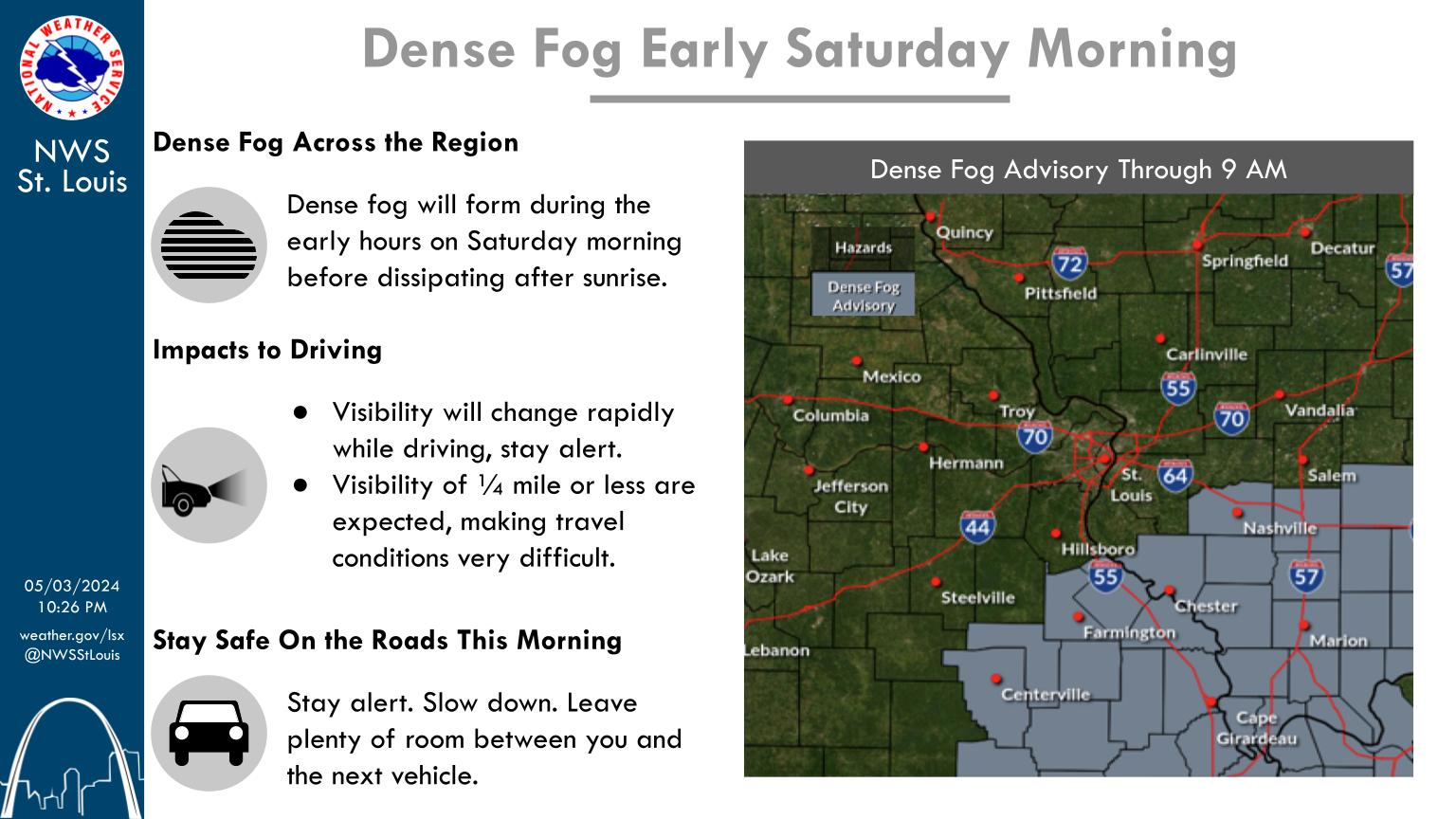 Weather Story
Weather Story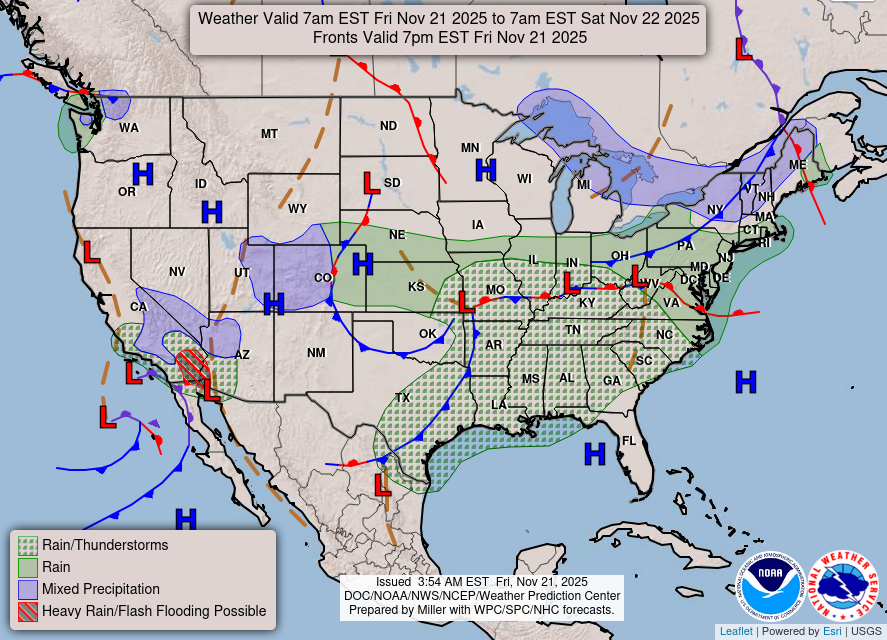 Weather Map
Weather Map Local Radar
Local Radar